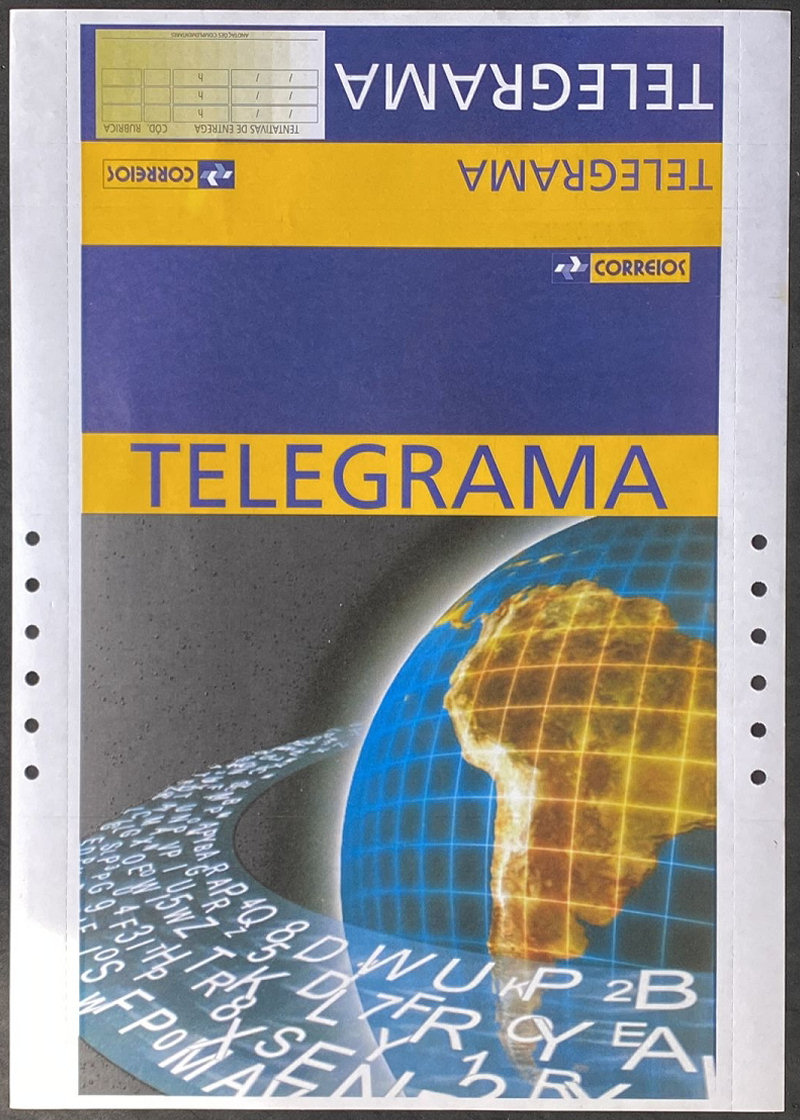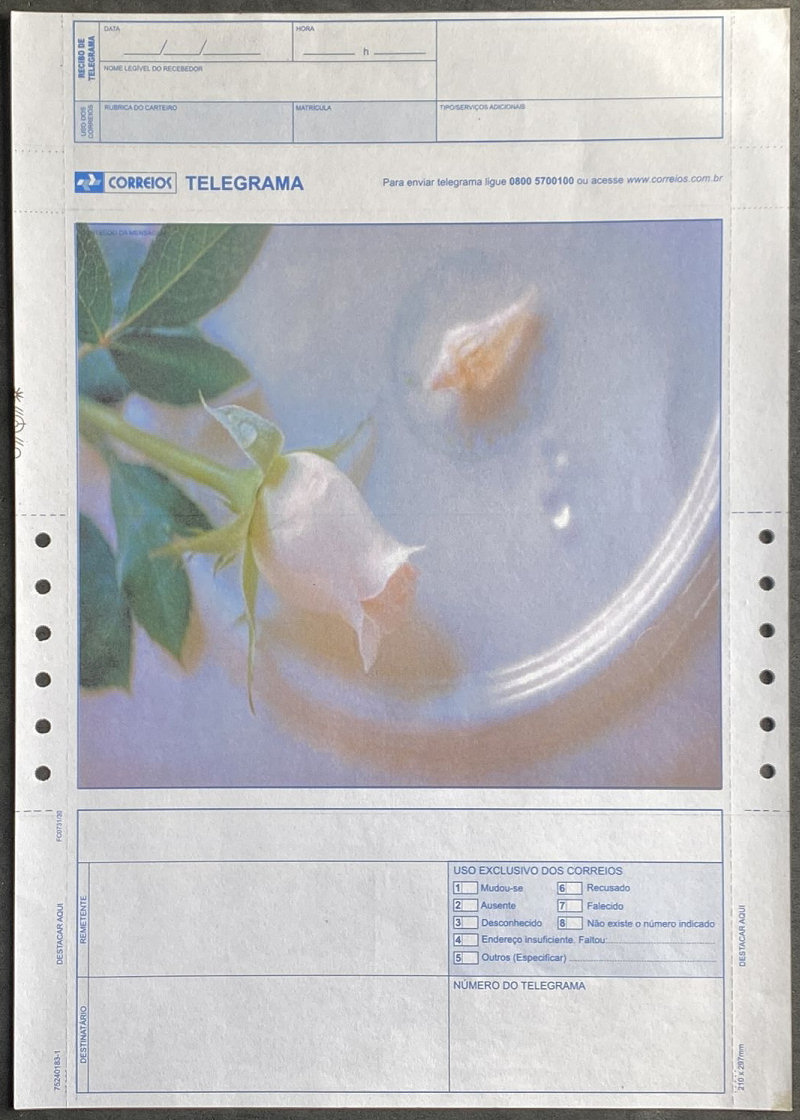| अनुवाद |
Übersetzen sie |
WORKING
|
Traduisez |
ترجم |
| перевести |
Traduca |
Traduzca |
翻译 |
|
Telegraph stamps of the World
Click here for a site-map. |
Select currency. Default = GBP (1.0)
|

On December 23, 1873 a connections were made between Rio de Janeiro, Belém do Pará, Recife and Salvador.
On June 22, 1874, the connection with Europe was completed, between the stations of Recife and Carcavelos (in Portugal), via Cape Verde and the island of Madeira. In 1875 the connection between Recife, João Pessoa and Natal was established.
Later, in 1893, the English company South American Cables Ltd. installed an undersea cable in the island of Fernando de Noronha. In 1914 the cable concession was transferred to France. A second submarine cable on the same island was launched by the Italian Italcable in 1925.
In 1895, a 1600nm cable was laid along the Amazon River by Siemens Bros. for the Amazon Telegraph Company. The cable needed frequent repairs due to the conditions. The route chosen was:
Belem (Para) → Cameta (on the River Tocantins)
Belem → Pinheiro (Ilha de Caratateua) → Mosqueiro → Soure across the Para River
↓
Breves (Ilha de Marajo)
Gurupa → Chaves (Ilha de Marajo) → Macapa (to the North)
Monte Alegre
Santarem, at the mouth of the Tapajos
Alemquer (now Alenquer)
Obidos (last point in Para, then Amazonas)
Parentins (was Villa Bella da Imperatriz, now Parintins)
Itacoatiara (was Serpa)
Manaos
|
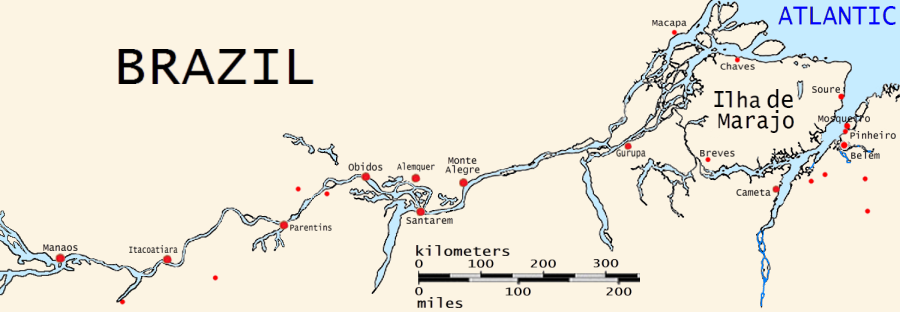 A detailed map of Para can be found on Wiki-Commons. Maps vary a lot. The Amazon basin is largely varying degrees of swamp with the towns occupying the high ground. Whether a spot in between is drawn as mainland, island or river depends on the season and perhaps the time of day. The tides influence the water level, as does the rainy season. It is said that the overall effect can change the water level by as much as 40 feet (12 meters) in places. Telegraph poles were impractical. Coastlines also change over time, as do place-names/spellings.
A detailed map of Para can be found on Wiki-Commons. Maps vary a lot. The Amazon basin is largely varying degrees of swamp with the towns occupying the high ground. Whether a spot in between is drawn as mainland, island or river depends on the season and perhaps the time of day. The tides influence the water level, as does the rainy season. It is said that the overall effect can change the water level by as much as 40 feet (12 meters) in places. Telegraph poles were impractical. Coastlines also change over time, as do place-names/spellings. |
Telegraph Routes.
Telegram forms of 1921 and 1932 show route-maps on the back and list the following companies supplying services :
| Interior (1921 and 1932) |
| Radio Amazonas — R. G. dos Telegraphos. |
| Western — The Western Telegraph Co. Ltd. |
| AMAZON — The Amazon Telegraph Co. Ltd. |
| Exterior (1921) |
DAKAR (Senegal)
TALISMAN (Azores?) |
|
Cie. des Cables Sud-Américains. |
| WESTERN — The Western Telegraph Co. Ltd. |
| SALINAS — Cie. Française des Cables Télégraphiques. |
MONROVIA (Liberia)
MONTEREES (California ?) | | Deutsch Sudamerikanische Telegraphengesellschaft AG. |
GALVESTON (Texas)
COLON (Panama) | | Central & South American Telegraph Co. |
| URUGUAYANA — Administração Argentina |
| LIVRAMENTO (Azores) — Administração Oriental |
| JAGUARÃO (bordering Uruguay) — Administração Oriental |
|
| Exterior (1932) |
| DAKAR (Senegal) |
|
Cie. des Cables Sud-Américains. |
| WESTERN — The Western Telegraph Co. Ltd. |
| COLON (Panama) | | Central & South American Telegraph Co. |
| URUGUAYANA — Administração Argentina |
| LIVRAMENTO (Azores) — Administração Oriental |
| JAGUARÃO — Administração Oriental |
| ITALCABLE — Administração Italiana |
| RADIOBRAZ — Companhia Radiotelegraphica Brasileira |
|
The First Brazilians Railroads.
| Name |
Year |
From - To |
Ext. |
State |
| Imperial Companhia de Navegação e Vapor e Estrada de Ferro Petrópolis. (E.F. Mauá) |
1854 |
From Praia da Estrela(Guia Station of Pacobaíba) to Fragoso (Vila Inhomirim) |
14,5 |
Rio de Janeiro |
| Recife and S. Francisco Railway Company |
1858 |
From Cinco Pontas to Cabo |
31,5 |
Pernambuco |
| Companhia Estrada de Ferro D. Pedro II (Central do Brasil) |
1858 |
From Corte to Queimados |
48,2 |
Rio de Janeiro |
| Bahia and S. Francisco Railway Company Limited (E.F. Bahia ao S. Francisco) |
1860 |
From Calçada to Paripe |
14,0 |
Bahia |
| São Paulo Railway Company Limited (EF Santos-Jundiaí) |
1867 |
From Santos to Jundiaí |
139 |
São Paulo |
| Estrada de Ferro Baturité (Rede de Viação Cearense) |
1873 |
From fortaleza to Porongaba |
9,1 |
Ceará |
| Companhia Brasileira Ltda, Estrada de Ferro Porto Alegre a Novo Hamburgo (Viação Férrea Rio Grande do Sul) |
1874 |
From Porto Alegre to São Leopoldo |
33,7 |
Rio Grande do Sul |
| Companhia Estrada de Ferro d'Oeste (E.F. Oeste de Minas) |
1881 |
From Sítio to Barroso |
49 |
Minas Gerais |
| Compagnie Générale de Chemins de Fer Brésiliens (E.F. Paranaguá-Curitiba) |
1885 |
From Paranaguá to Morretes |
40,9 |
Paraná |
Early telegraphs were more easily laid beside railway tracks.
I have gleaned information from these and other sources to put together the map below:
According to Introdução da telegrafia elétrica no Brasil,
from 1809, optical telegraphs were used to warn of the approach of foreign vessels. These telegraphs
were located in Ponta Negra (Maricá), Cabo Frio, Itaipu (Niterói) - north of the city of Rio de Janeiro - in the hills of Babilônia (Copacabana) and the Castle, and in the
fortresses of Villegagnon.
Experiments were begun in 1851 with Electric telegraphy (ostensibly to combat the slave trade). These were successful enough to warrant the ordering of Morse telegraph apparatus and gutta-percha insulated cables from E. Stochrer in Leipzig. These were received March 15, 1852. On May 11, 1852, the first telegraph line was installed between Campo da Aclamação (now Campo de Santana) and Paço de São Cristóvão, in Rio de Janeiro. This was extended to include local military police and fire departments. It saw little use.
On January 17, 1854 a telegraphic centre was established to extend communications to Petrópolis (site of Emperor's summer palace) and Niterói, then beyond
the urban perimeter, it would follow the line by the way of Botafogo until the Lagoon, by the road of the Andaraí
to Tijuca, through Laranjeiras to Corcovado.
The first non-military telegraph line in Brazil was in January 1857 with the telegraph line, between Petrópolis and the Health beach at Rio de Janeiro,
the total length was 50,630 meters, including 14,970 meters of submarine cable in the bay of Guanabara.
next to the Institute of the Blind Boys, a submarine cable stretched 7,050 meters until the Ponta of Matoso on Ilha do Governador. From there, an air line with a length of 6,160 meters
Pinion Bag. From this extreme, another submarine cable of 7,920 meters departed to the bridge of Mauá, where was attached to the airline of iron wire, that followed next to the line of the train until the Root of the Serra da Estrela and from there to Petrópolis (site of Emperor's summer palace), stretching further 29,500 meters. From Praia da Saúde to Petrópolis, the total length was 50,630 meters, being 14,970 meters of submarine cable in the bay of Guanabara.
Despite the intention to extend the telegraph to Cabo Frio, Bahia, Pernambuco, Maranhão and Rio Grande do Sul, at the end of 1858, the telegraphs in Brazil was still restricted only to the capital and surroundings and almost exclusively to the services of the Court. On August 1, 1858, the free transmission of correspondence by the electric telegraph between the Prainha and Petropolis Stations, which was in front of the Hotel de Bragança, was franked. Two postal workers were hired for delivery of telegrams, one in Petrópolis and another in Prainha, in the Court. 8 months later, 1829 telegrams had been sent, still free of charge.
In 1861 it was decided that the General Bureau of Telegraphs should build its own land lines, moving progressively northwards, taking the line to São João da Barra and, year after year, progressing with the extension of the line according to approved credit.
Decree No. 3.288, of July 20, 1864 merged the optical and electrical telegraphs. Optical stations were fitted with electric telegraphs. Employees unable to use the electric telegraphs were dismissed and a workshop for repair of telegraph equipment was established in April 1865 at No.39 Campo da Aclamação. Due to the inability to decide between public and private development of the telegraphs and whether to involve foreign companies, the network spread slowly. Then came the Paraguayan war (1864-70). This both rapidly expanded the network in the south and delayed plans for the north. From September 1865 to June 1866 the south was connected to the front. Siemens provided cable for 17 submarine sections that degraded rapidly and Siemens had to replace them (some twice).
The South line followed the following route:
from the capital it connects to Itaguaí, Mangaratiba, Angra dos Reis, Parati,
in Rio de Janeiro; Ubatuba, São Sebastião, Santos and Iguape,
in São Paulo; Paranaguá,
Paraná; São Francisco do Sul, Itajaí, Desterro (Florianópolis) and Laguna,
in Santa Catarina; Torres, Conceição do Arroio and Porto Alegre,
in the province of São Pedro do Rio Grande do Sul.
(17 stations)
The terrestrial telegraph networks were constructed by the General Office of the Telegraphs, a government company under the direction of Guilherme S. de Capanema. However, the concession given to Kieffer in 1869 (Decreto n. 4350, de 5 de abril de 1869 Brazil) to extend a land line between the Court and Ouro Preto indicates an attempt by the Brazilian government to experiment with the use of foreign companies in the development of telegraphy. Although the telegraph line constructed by Kieffer operated with success, no further concessions were made to terrestrial telegraph lines during the Empire, except the lines that served the railways. The classes initially given by Capanema and his assistants marked the beginning of the study of telegraphy in Brazil. Although in a precarious way, limited to practical interests and attracting a group of workers with low school education, the telegraphy developed and aroused interest. Subsequent to the period analyzed in this article, the study of telegraphy became part of the curriculum of some secondary schools, demonstrating the importance given to the subject.
At the top of the map, Cayenne connects to Paramaribo in Suriname. These two were connected in 1891, with Cayenne connected on to Port au Prince(Haiti), Fort-de-France(Martinique), Puerto Plata, (Dominican Rep.) and Guadeloupe (The Saints Island).
In 1892 LA COMPAGNIE DES CÂBLES SUD-AMÉRICAINS laid a 1620 nm long cable from Dakar, Senegal to the island of Fernando de Noronha, Brazil and then a 347 nm long cable to Pernambuco. The system was extended in 1910-11 when Norddeutsche Seekabelwerke laid cables, Conakry, French Guinea - Monrovia, Liberia 309 nm and Monrovia - Grand Bassam, Ivory Coast 500 nm.
In 1924 CS. Faraday (2) laid cable from Cape St Vincent(Portugal) to Fernando Noronha, and from there on to Rio de Janeiro for Italcable. This was rerouted to Reciffe in 1951.
The cable at the bottom goes from Rio de Janeiro to Montevideo and Buenos Aires.
A list of 1906 for wireless-Telegraph stations lists 3 Telefunken Station with a range of 200km at Ilha Grande (near Rio de Janeiro), Fort Santa Cruz (near Rio de Janeiro) and Ilha de Cobras, Guanabara Bay a little west of Rio de Janeiro.
There were also 3 Shoemaker 10 KW sets at Para (Belem area), Santarem and Manaos.
This is here to get consistent results on different browsers. |
|
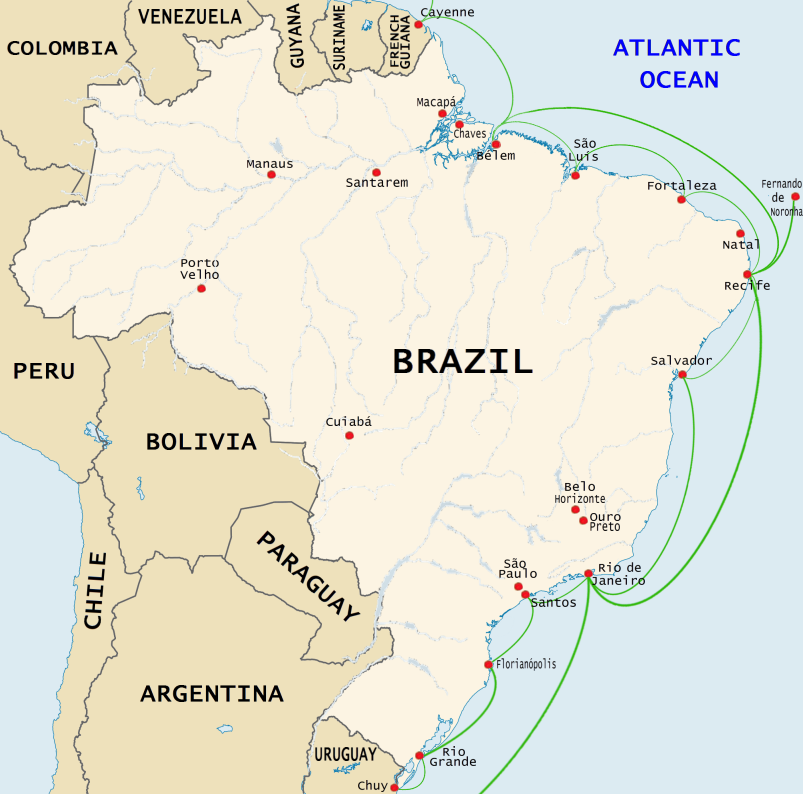
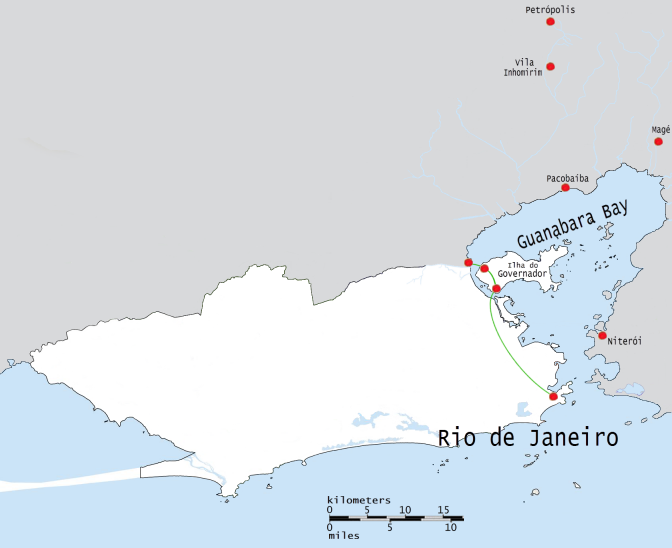
The Brazilian coast, 7,400 km long, was connected by 182 telegraph stations by 1886. |
I have completely revised Hiscocks' original listing, though leaving references to the original designations.
I have now brought the prices up to date and added currency selection.
The new designations have 'RH' numbers (Revised Hiscocks) to avoid confusion.
CheckList Setup |
BRAZIL.
1863 Stamps were not actually authorized until 1869, but these were used anyway (but see my note below).
Printed on thin self-coloured card (0.35 to 0.4 mm) in horizontal strips of four by C. Leopoldo Heck. Imperf.
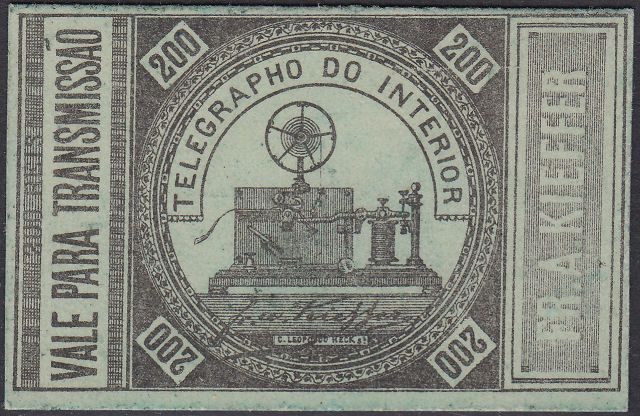
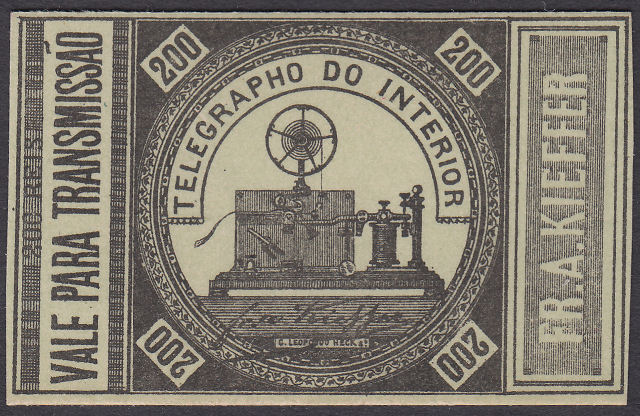

Type 1 - RH1, RH1a and RH1b (scanned together).
| New # |
Type. |
was |
Description |
Mint |
Used |
| RH1 |
1 |
H4 |
200r black / pale green |
150.00 |
200.00 |
| RH1a |
|
H4a |
black / greenish yellow |
120.00 |
150.00 |
| RH1b |
|
H4b |
black / ivory |
120.00 |
150.00 |

A pair of RH1 courtesy of Beto Assef Filatelia (click image for listing).
Hiscocks added the following 2 notes:
| Note. 1 Pairs and strips carry considerable premium. |
Note. 2 No. 4 may be found with or without control numbers handstamped in red or blue on the right hand label.
According to one reference No. 4 was always given a control number before use and pen cancelled in use.
This would suggest that unnumbered copies are remainders. |
My note: There is some uncertainty about where this issue fits in the scheme of things.
Steve Hiscocks listed it as the second series, but with a date of 1863 which would make it the first.
Both John Barefoot
and I have re-sequenced them accordingly.
I have however recently been sent a copy of a catalogue page written in Portuguese and in colour, that puts this as the second series with a date of 1873.
It is therefore possible that the date of 1863 was an error, although it seems reasonable that an issue so prominently bearing the name of the creator of the line would come first.
Anyone have a dated, used example of these ?
The only one of these that I have seen that appeared like it may have been genuinely used has no signs of a control number.
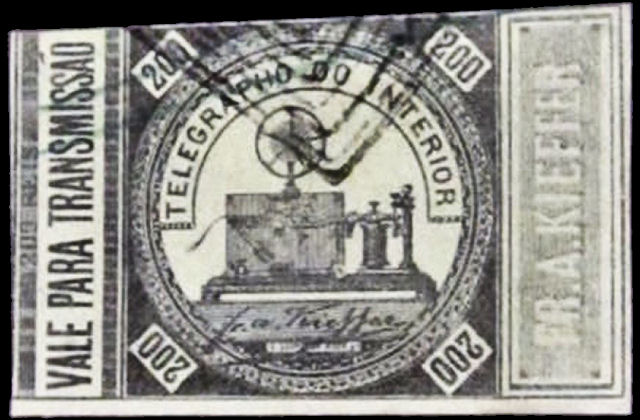
1869 Lithographed by L.Heck on white wove paper. No watermark. Imperf.
Control number in circular stamp (bluish green) on reverse. Taken from the centre of the earlier design.
 |
 |
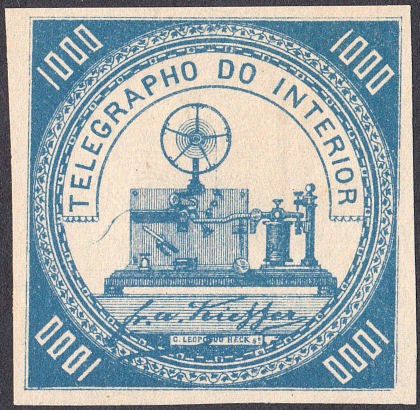 |
| Type 2 (RH2b), (Note 200's on white rectangles) |
Type 3 (RH3a), (Note the rectangular zeroes) |
Type 3 (RH4b), (Note the rectangular zeroes) |
| New # |
Type. |
was |
Description |
Mint |
Used |
| RH2 |
2 |
H1 |
200r light green |
75.00 |
75.00 |
| RH2a |
|
H1a |
green |
90.00 |
90.00 |
| RH2b |
|
H1b |
without control on reverse (light green) (1871) |
20.00 |
15.00 |
| RH2c |
|
H1c |
as RH2b but green |
30.00 |
24.00 |
| RH3 |
3 |
H2 |
500r flesh to pale rose-carmine |
90.00 |
90.00 |
| RH3a |
|
H2a |
without control on reverse (1871) |
12.00 |
20.00 |
| RH3b |
|
H2b |
watermarked "LACROIX FRERES" |
150.00 |
- |
| RH4 |
3 |
H3 |
1000r light blue |
60.00 |
60.00 |
| RH4a |
|
H3a |
deep dull blue |
60.00 |
60.00 |
| RH4b |
|
H3b |
without control light blue (1871) |
15.00 |
20.00 |
| RH4c |
|
H3c |
without control deep dull blue (1871) |
20.00 |
24.00 |
| RH4d |
|
H3d |
as No. 3(c) but perforated |
- |
- |
|
|
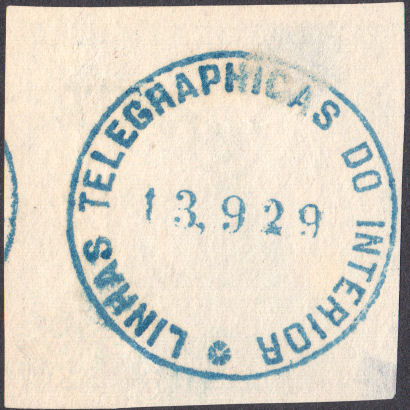
Control on reverse. |
Hiscocks added the following 2 notes:
Note. 1 The status of No. 3d is uncertain but a copy so described
was included in the 'Burrus' sale in 1963. |
| Note. 2 The above stamps were printed in sheets of 96 (8 x 12). |
1873 As above but with rounded numerals in white on a coloured background.
White wove paper. No watermark or watermarked "LACROIX FRERES". Imperf.
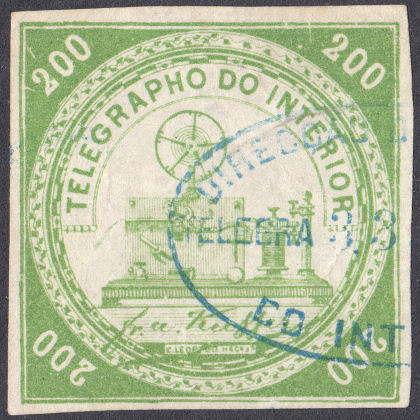 |
 |
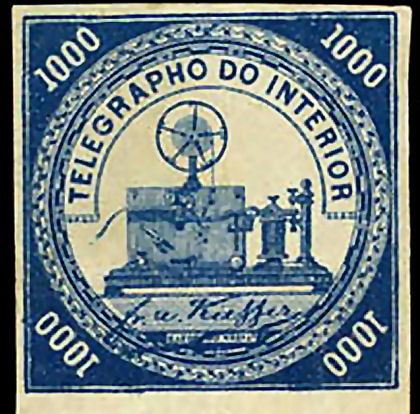 |
| Type 4 (RH5). |
Type 4 (RH6), (Note the rounded zeroes) |
Type 4 (RH7), rounded zeroes, from
Wikimedia Commons |
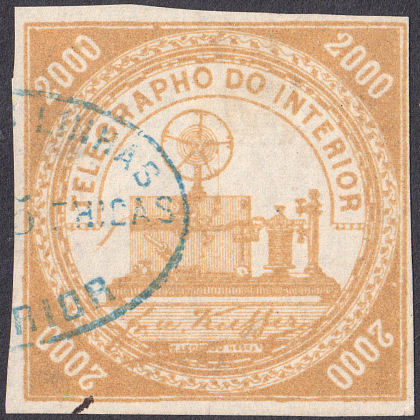 |
|

This is headed "Repartição Geral dos Telégrafos" (RGT).
The National Post Office Museum in Rio de Janeiro is reported to contain
14 volumes of annual reports from 1862 to 1897 for the RGT.
John Barefoot notes that the precise positioning of half a cancel
on each stamp suggests that they are cancelled remainders.
Sounds very reasonable, but here is a used form, courtesy of Spink and Son.
This is however a vertical pair. |
| Hiscocks type 4 (RH8). |
| |
| New # |
Type. |
was |
Description |
Mint |
Used |
| RH5 |
4 |
H5 |
200r yellow green |
100.00 |
70.00 |
| RH5a |
|
H5a |
on watermarked paper |
200.00 |
140.00 |
| RH6 |
4 |
H6 |
500r red-orange |
90.00 |
60.00 |
| RH6a |
|
H6a |
on watermarked paper |
180.00 |
120.00 |
| RH7 |
4 |
H7 |
1000r deep dull blue |
300.00 |
200.00 |
| RH7a |
|
H7a |
on watermarked paper |
600.00 |
400.00 |
| RH8 |
4 |
H8 |
2000r bistre |
90.00 |
65.00 |
| RH8a |
|
H8a |
on watermarked paper |
180.00 |
120.00 |
1899 (27 March). Lithographed on white wove paper. No watermark. Perf. 11½.
These were for experimental use on a line between stations within Rio de Janeiro:
Central, Niterói, Fortaleza de Santa Cruz,
Rio Comprido, Engenho Novo, Praça da República,
Largo Leões, Prainha, Santa Tereza, São Cristóvão and Largo do Machado.
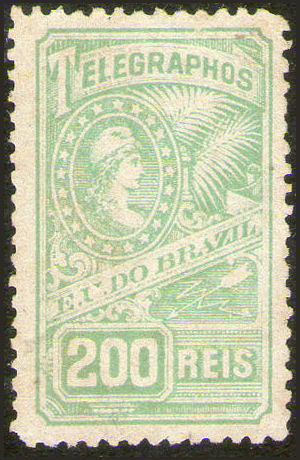 |
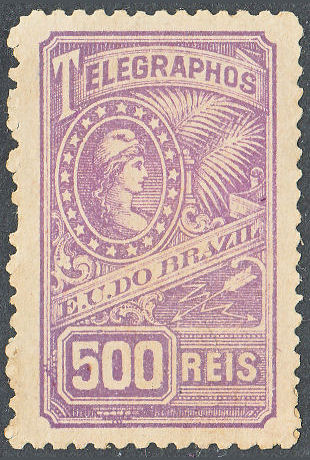 |
 |
| Hiscocks type 5, (RH9). |
Hiscocks type 5, (RH10). |
RH10a courtesy of Randall Chet. |
|
The RH10a example above was used at Rio Comprido.
The "OUT" is an abbreviation of Outubro, Portuguese for October.
| New # |
Type. |
was |
Description |
Mint |
Used |
| RH9 |
5 |
H9 |
200r pale bluish green (50,000) |
15.00 |
65.00 |
| RH10 |
5 |
H10a |
500r purple (30,000) |
90.00 |
90.00 |
| RH10a |
|
H10 |
brown-lilac |
180.00 |
100.00 |
The image on the right of 30 July 1902
looks like it was brown-lilac,
but perhaps faded due to the climate or something.
It has an unusual cancel but the location is hard to read.
Image courtesy of Schuyler Rumsey Philatelic Auctions. |
|
 |
Note: I have reversed #10 and #10a as I am not convinced that the brown-lilac is not a colour changeling.
I have indicated this colour in the listing. Anyone have a mint example in brown-lilac ?
Imperforate proofs of type 5 are known with a face value written as 5.000 REIS and in 5 different colours.
The colours are: red, blue, green, dark brown and blue-green.
Later.
Agencia Postal Telegraphica.
The use of Telegraph stamps was discontinued about 1905, but telegrams still had to be paid for so normal postage stamps were used.

A complete cancel of the Agency on a block of 6 x 400 Reis stamps. with "Agencia Postal Telegraphica" around the top, "ARASSUAHY" (a town in the state of Minas Gerais),
below that, the date "7 MARC 1942", then "Yhesouraria?" (Tesouraria = Treasury ?)
and at the bottom "Minas Geraes" (Minas Gerais)
Image Courtesy of Gabriel Coutinho de Gusmão.

A 500 Reis stamps with a Telegraph cancel of São João do Montenegro dated 4 August 1933 courtesy of Beto Assef Filatelia (click image for listing).
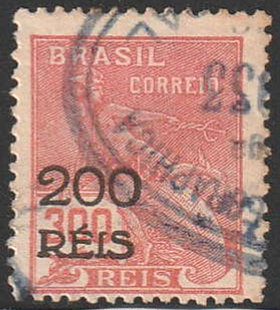
Telegraph cancel used in 1933.
Courtesy of Gabriel Coutinho de Gusmão. |
|
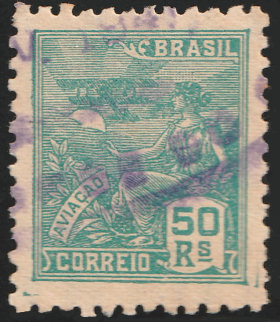
Telegraph cancel (probably) used in 1941.
Courtesy of Gabriel Coutinho de Gusmão. |
Stationery
National Telegrams.
Repartição Geral dos Telegraphos
Headed "Repartição Geral dos Telegraphos" = "General telegraph office"
A fairly simple telegram form 2, dated 26 May 1906 and used in Jaragua.
There is "(2)" at the top-right that is likely to be the form number.

Image Courtesy of Gabriel Coutinho de Gusmão.
Here is another form 2, this dated 9 December 1911 and used in Central Rio de Janeiro. Stamped "URBAN". There is "(2)" at the top-right again.
This time though there is a space at the top for the address to facilitate folding, sealing and mailing. No sign of the seal though.
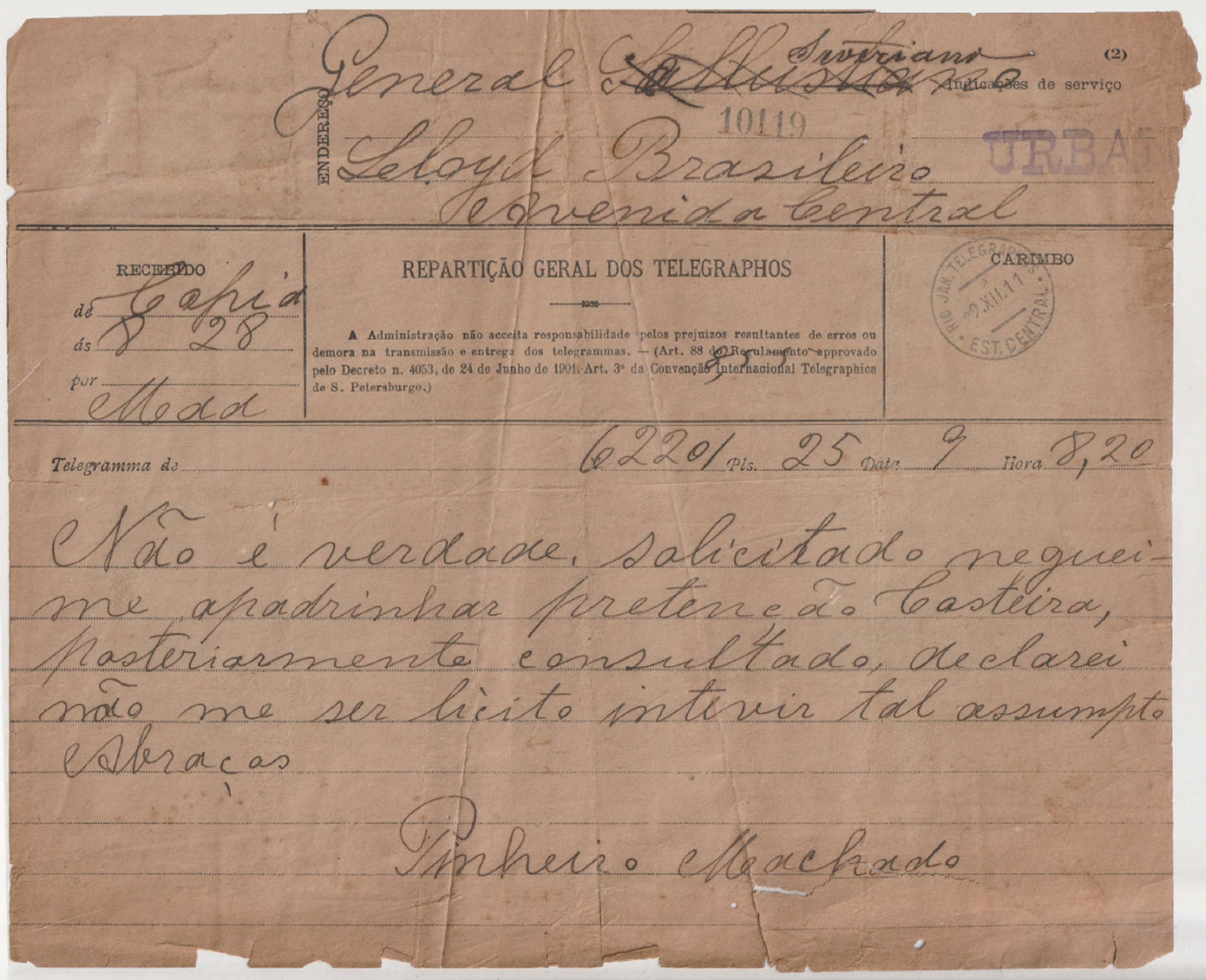
Image Courtesy of Gabriel Coutinho de Gusmão.
Here is a fairly simple telegram form dated 2 April 1921 and used in São Paulo.
The address is at the top to facilitate folding, sealing and mailing. Possible signs of a wax seal.
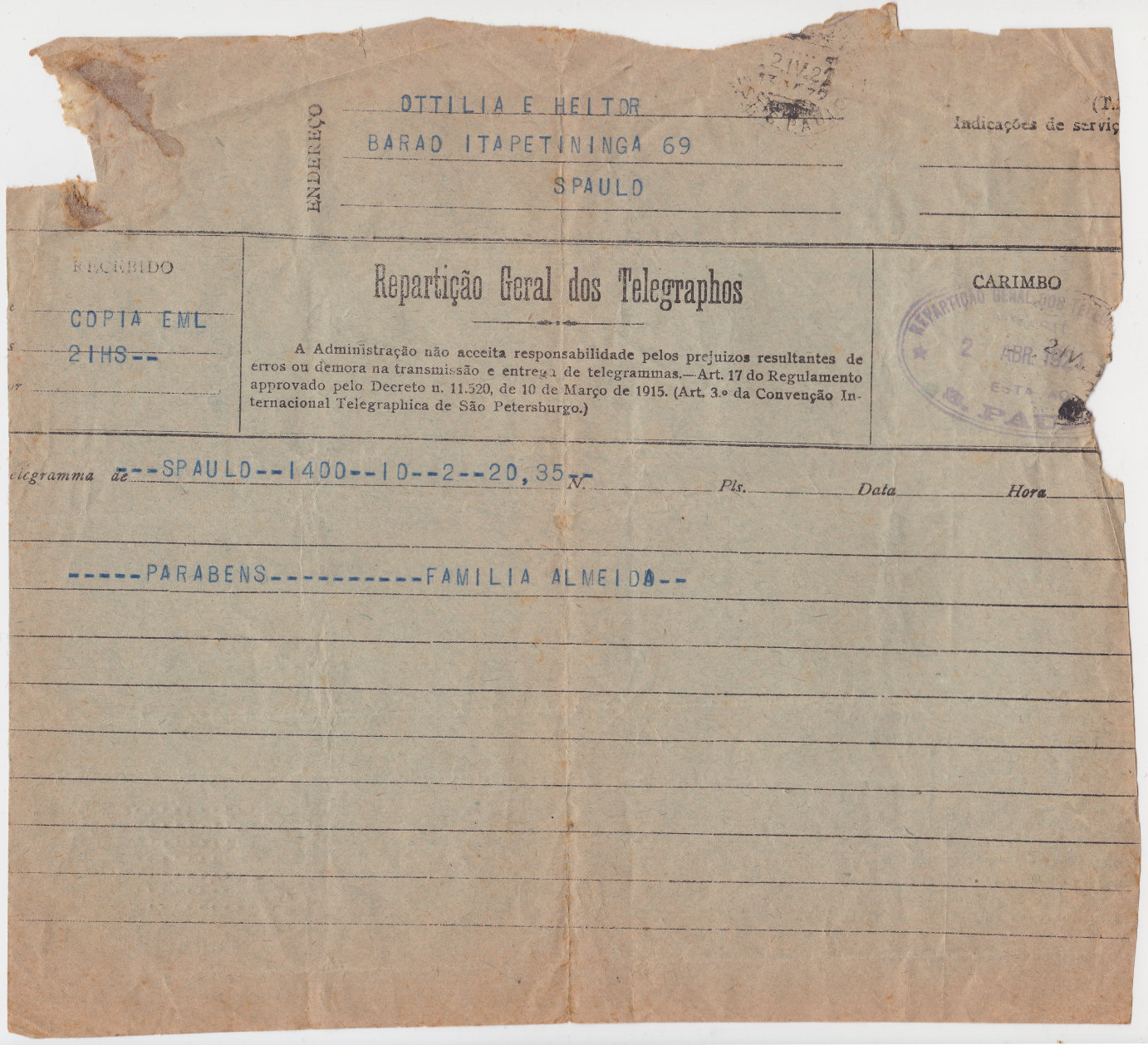
The back has a logo, lists of codes, offices and an impressive map.
It also lists companies handling connections to external destinations.

For the interior it gives :
Radio Amazonas, The Western Telegraph Co., and The Amazon Telegraph Co.
A telegram dated 3 September 1922 and used in São Jeronymo, Rio Grande do Sul .
This now has a Logo on the front, matching the seal. Nothing on the back.
This is stamped "Official" in large letters.
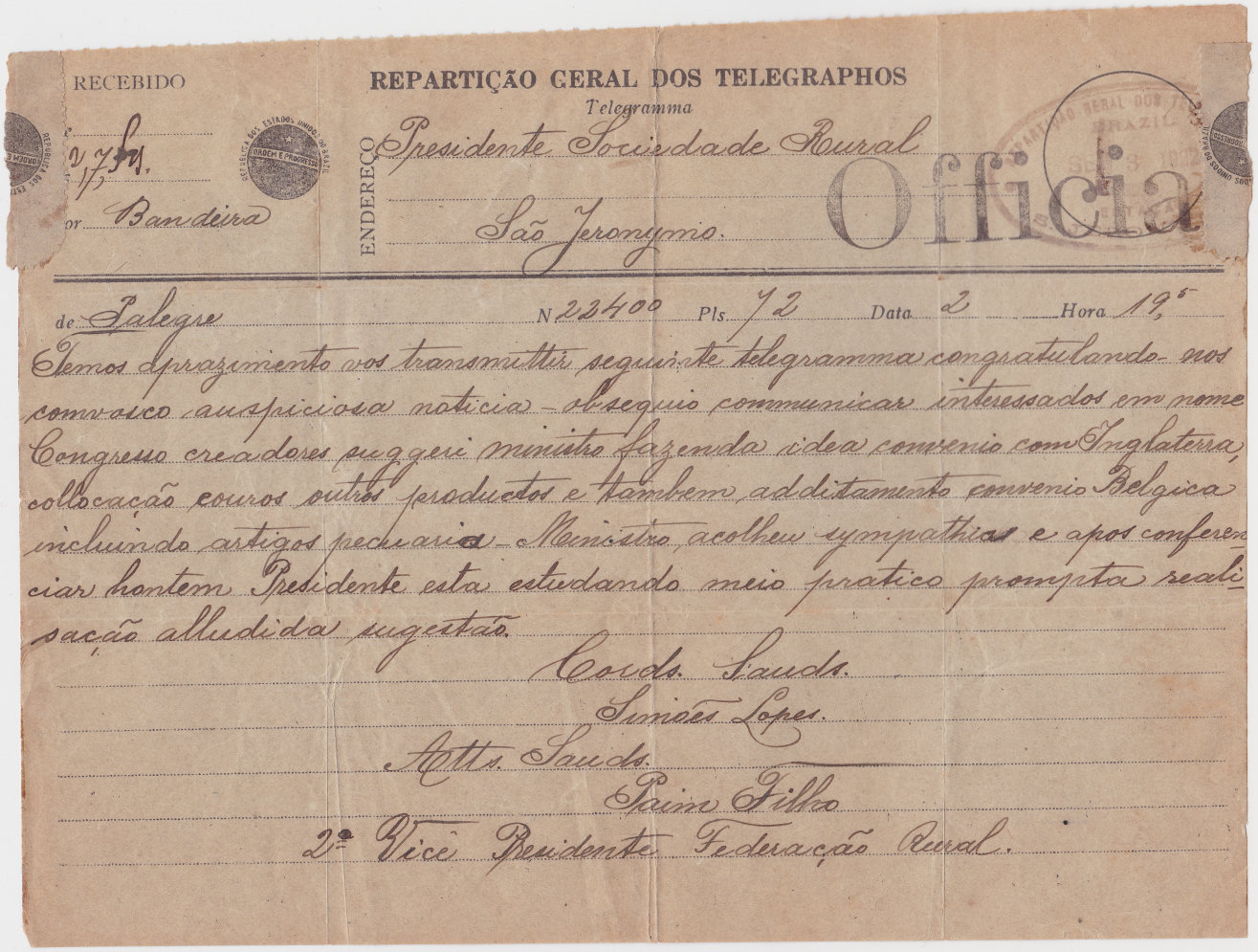
Another Official Telegram used in Lavras, Minas Gerais, (from Pouso Alegre to the president of the military enlistment Board at Lavras).
This has a different seal, matching the new Logo on the back that now has a map.
"Official" is written at top-right.
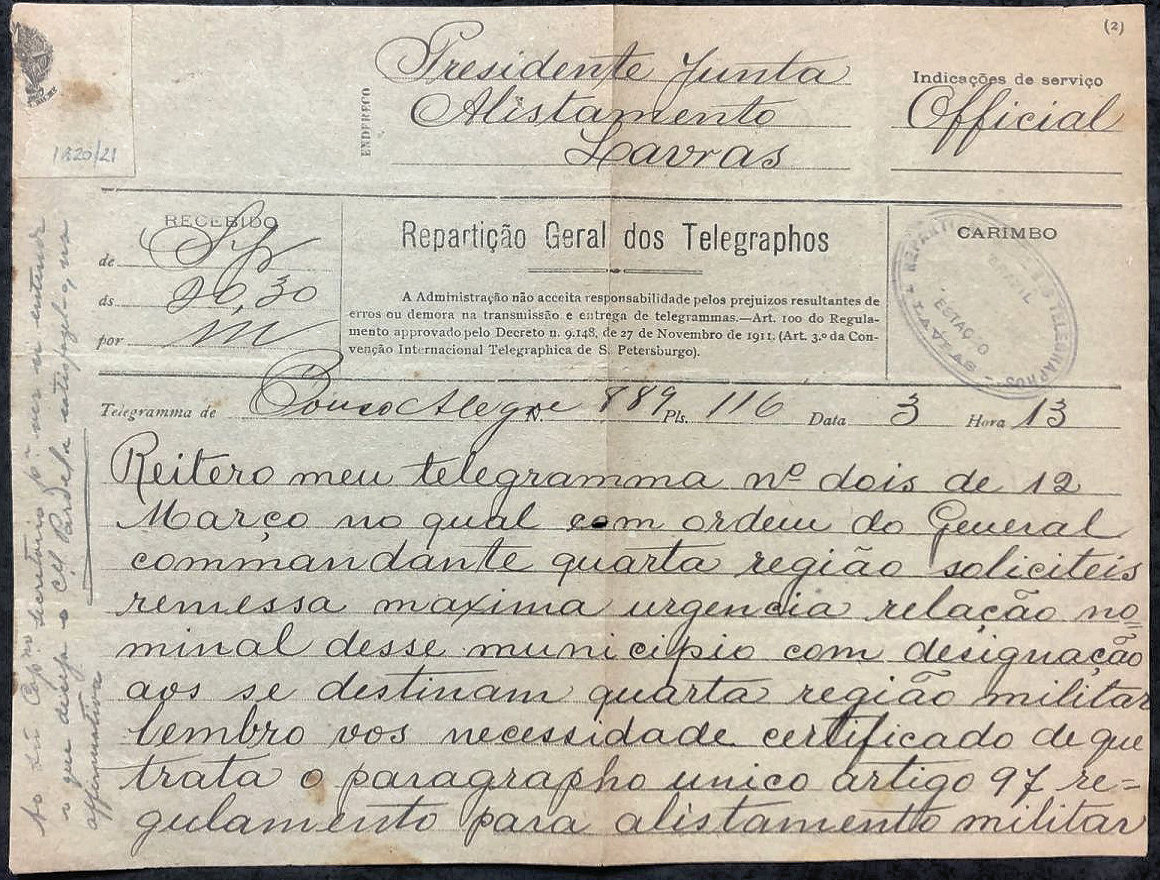
 |
 |
Someone has written 1920/21 on the seal, but the previous seal was used until at least 1926 and the Logo until at least 1932, so that would seem to be unlikely. The date-stamp is hard to see, but enhancement suggests that the last digit is an "8".
Having said that, the information on the map on the back looks like the style of the 1921 type rather than the 1930's types below with the old Logo.
Perhaps Presidents got the latest Logos/seals, whereas the rest of the country had to use up the old stock first ?
On the other hand, perhaps the new Logo was added to the old-style map they had on file.
This Logo was later used by the Government Departmento dos Correios e Telégrafos. |
 |
The back.

Images courtesy of Beto Assef Filatelia (click image for listing).
A telegram dated 6 August 1926 and used in Central Station (Rio de Janeiro ?)
Similar to lat. The Logo and "ENDERECO" are larger. Signs that something was torn off from above with another datestamp. Nothing on the back.

I have four examples of telegrams all apparently dated 16 May 1932 and used in São Paulo.
They are all mutilated to some extent. I will show two of them.
The first shows the complete date and a large portion of the map that is on the back again.

The back has a lists companies handling connections to internal and external destinations, a lists of codes, and a map.

The second shows more of the top. Clearly something was torn off from above with another datestamp. I suspect it was a receipt.
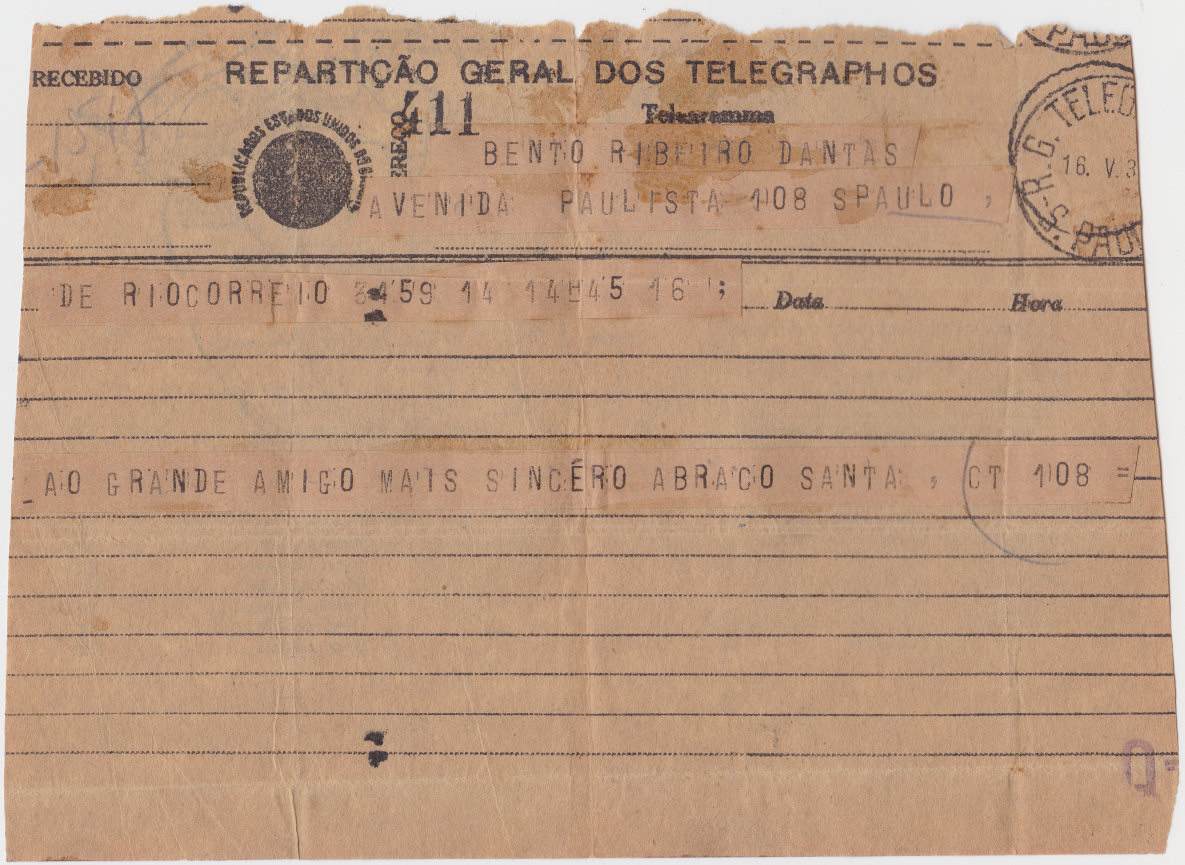
The back has not quite as much of the map, so the front and back are not accurately aligned.

All four of mine have this red mark at the bottom.
Departmento dos Correios e Telégrafos
A new type of Government Telegram, this dated 25 December 1939.
This seems to be stamped "ILHA DO GOVEREUSE", perhaps an old spelling of "ILHA DO GOVERNADOR" in Rio de Janeiro ?
Top-right is an imprint of "MOD. 562 (ANT. T2)", so I take 562 as the form number of the front (with T2 as the previous), but see the back.
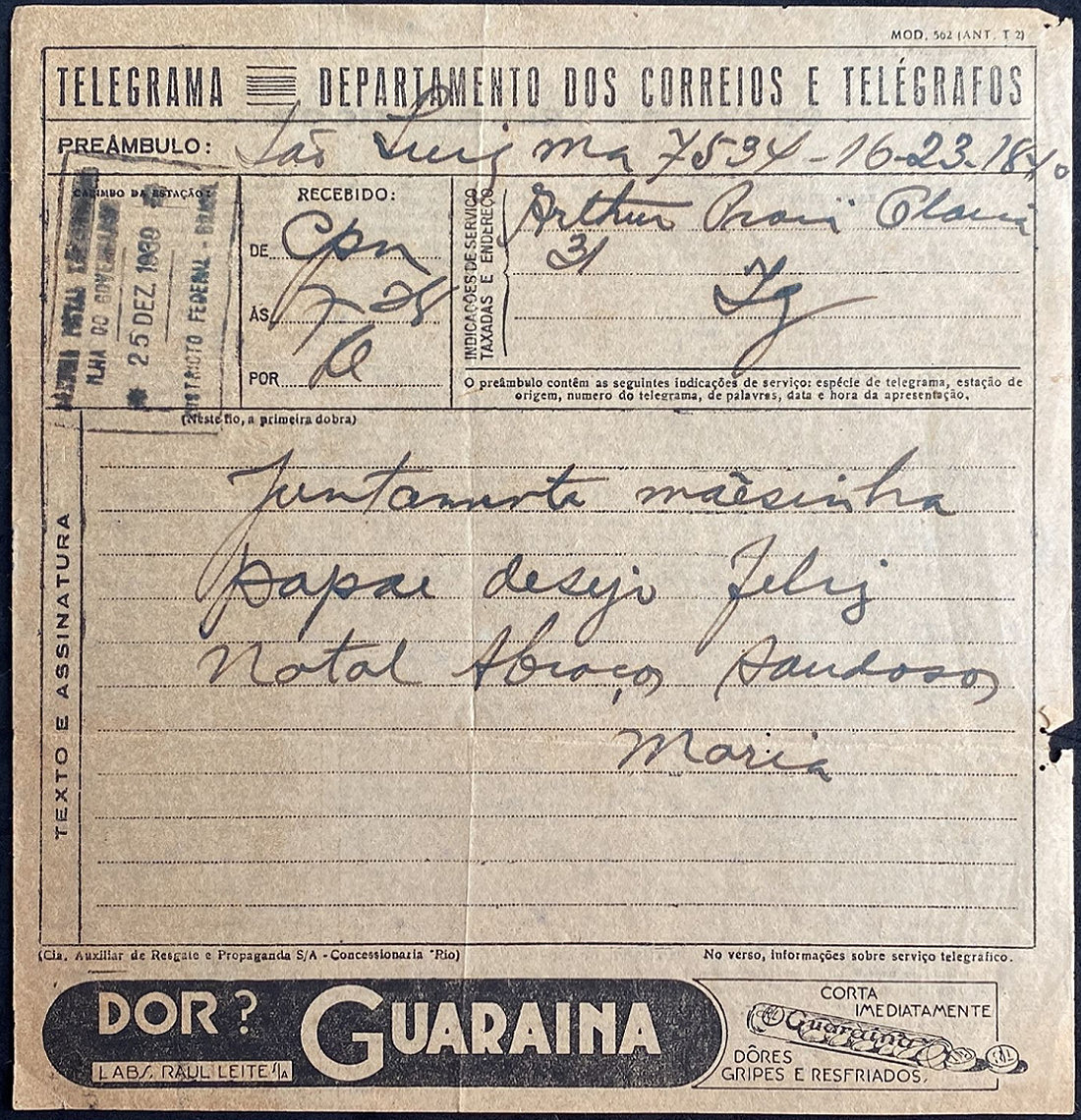
The bottom carries a medicinal advertisement and information on how to advertise.
 The back has a different Form number, No.5 and gives details of Telegraph Services.
The back has a different Form number, No.5 and gives details of Telegraph Services.

The bottom has a Note that says something like "Note: the information contained in Formula No. 5 supplemented by that of Formula No. 6 which refers to the various services of the DOF.
The present model of printing No. 562 was prepared by the School of Post-Telegraph improvement."
(NOTA: As informações constantes desta fórmula n. 5 completadas pelas da fórmula n. 6 as quais [taxibeso versam?] os varios serviçes da DOF.
O presents modêlo do impresao n. 562 foi preparado pela Escola de Aperfeigasmento dos Correios a Telégrafos.)
Below that is "Pap. Ribeiro—Ouvidor, 164—Rio" (Ouvidor = Ombudsman). Images courtesy of Beto Assef Filatelia (click image for listing).
Emprêsa Brasileira de Correios e Telégrafos
A much later version, this Telegram is dated 12 May 1971. It was used in Castanhal, Pará.
"Emprêsa" means Company, so it looks like it was privatised at that point. Later telegrams suggested in got Nationalised again.
Notice that the top is chopped off, more on that below.
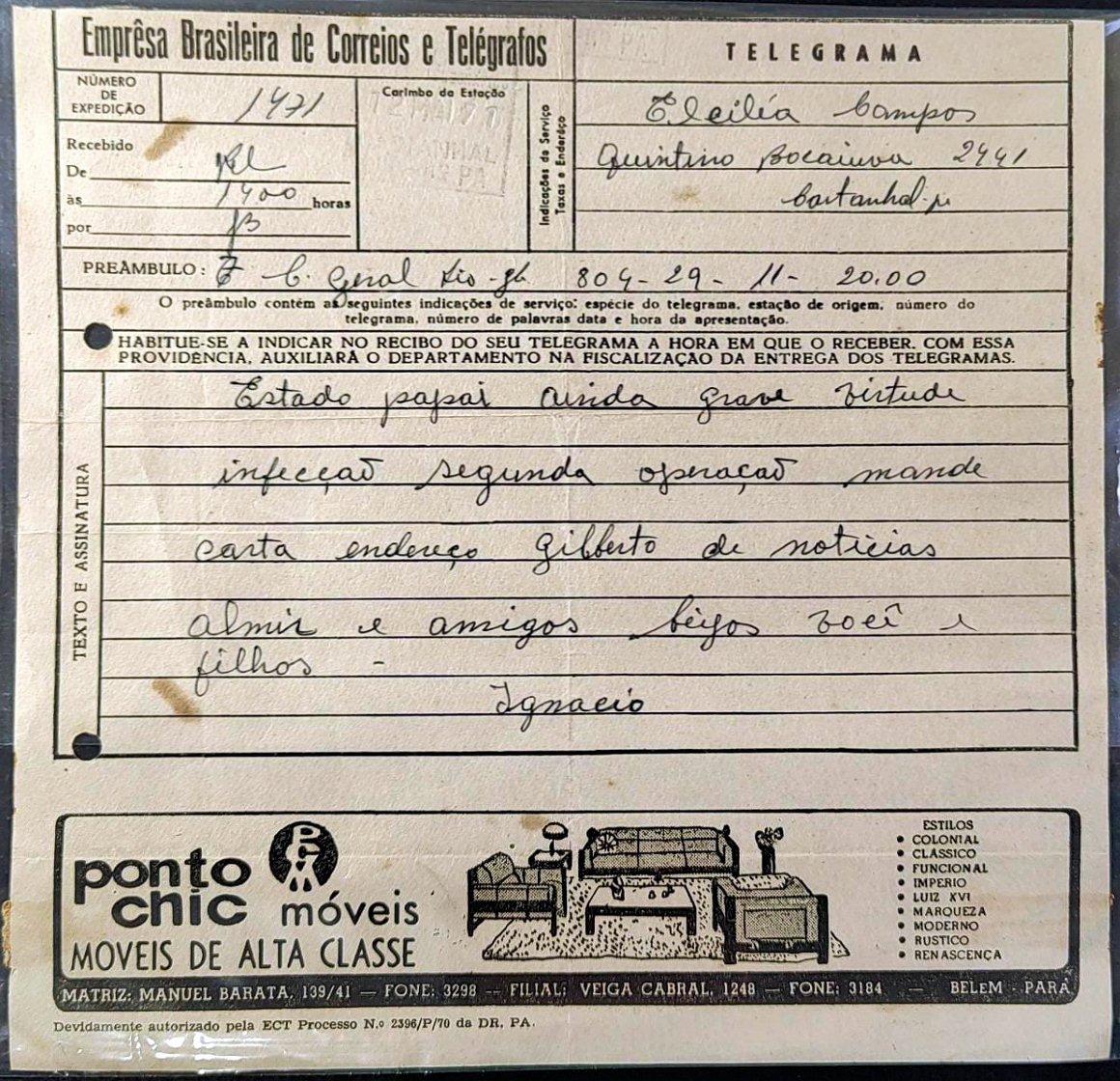
The bottom carries an advertisement and an imprint below:

"Davidamente autorizado pela ECT Processo No. 2396 / P / 70 da DR. PA." translates as "Duly authorized by ECT process No. 2396 / P / 70 of DR. PA."
The "ECT" I think stands for "Emprêsa de Correios e Telégrafos", the "70" probably indicates the year of printing as 1970. "PA" is the state of Pará (the second largest state).
Image courtesy of Beto Assef Filatelia (click image for listing).
By October 1972 the company was producing forms with colour advertisements. Below is a series of eight different ones. They all have the tops torn off and the reason is shown after them.
They all have an imprint of "MOD. 7530-007-0065" up the bottom-right side. The images are displayed at 80% size, download or display in another tab to see full size. Click on an image to see the listing.
Images courtesy of Beto Assef Filatelia (click an image for the listing).
Images courtesy of Beto Assef Filatelia (click an image for the listing).
Images courtesy of Beto Assef Filatelia (click an image for the listing).
Images courtesy of Beto Assef Filatelia (click an image for the listing).
www.correios.com.br
The following item uses the same Logo as the previous ones but Emprêsa Brasileira de Correios e Telégrafos has disappeared.

Did it get Nationalised ?
Now with high quality full colour images, though date unknown. Images courtesy of Beto Assef Filatelia (click an image for the listing).
Front and back of an envelope that may have been used by them.
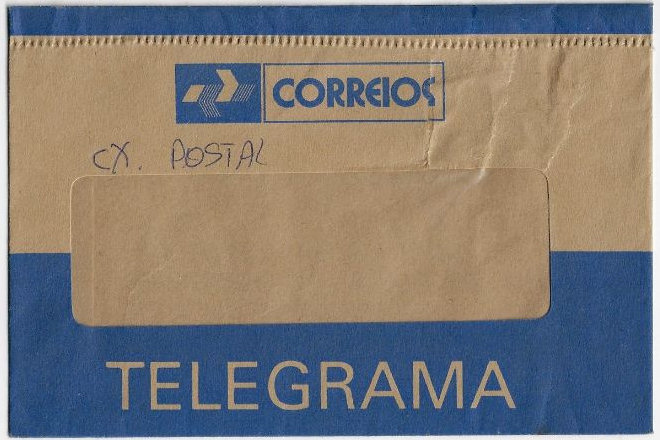

Ministerio da Viacäo e obras públicas = Ministry of Transport and Public Works
Departmento dos Correios e Telégrafos (DCT)
 |
I know nothing about the all-blue example to the left except that it has "May 2 1983 pencilled on the back.
and that it has the same Logo at the top as on the Official Telegram of 1928? above.
It can be seen to have a perforated-off section at the top for tearing off. It has a place for the Agency Stamp and name of the recipient,
as well as identifying it as a "Telegrama Social".
The used multicolour example below is missing that section which presumably stays as a record at the receiving office.
Other parts are re-arranged. "Telegrama Social" is now at the top-left with the destination at top-right. I presume that this is a later one.
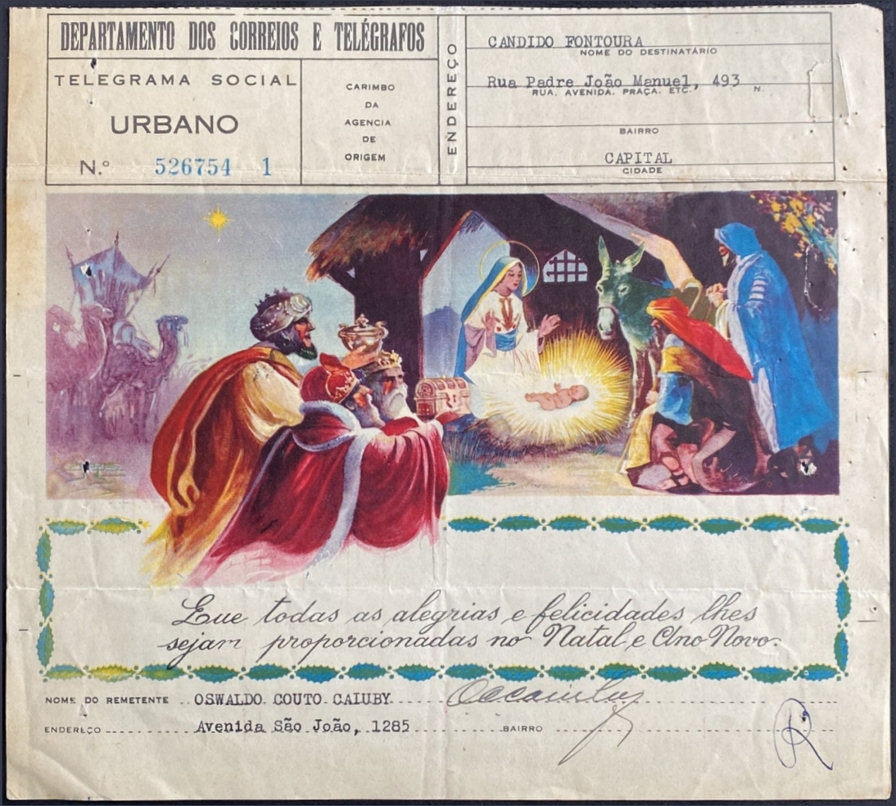
The Sender's name and ddress is added to the bottom, below the message. |
Images courtesy of Beto Assef Filatelia (click an image for the listing).
Ministerio da Viacäo e obras públicas with Logo as above, but with Cr$2,00 to cover postage. (not cancelled, otherwise we would know the date!)
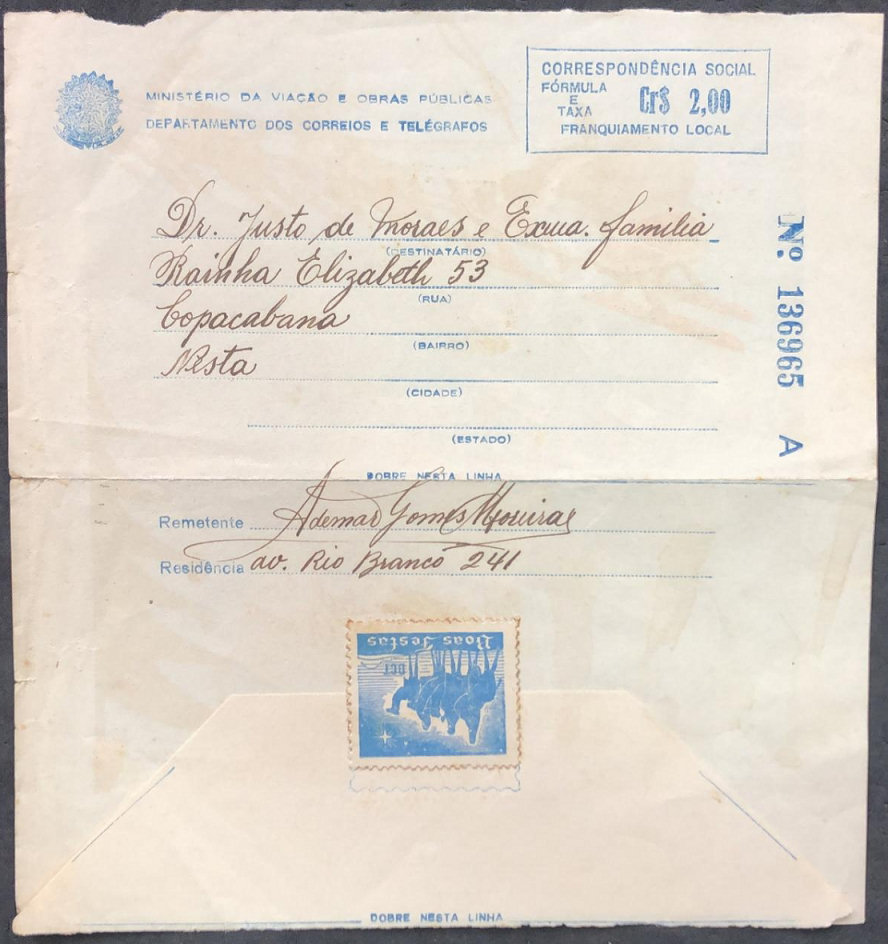
The flap is probably ungummed so a seal is used. It is marked Boas Festos = Happy Holidays and DCT (Departmento dos Correios e Telégrafos) |
Multicoloured Greetings inside.
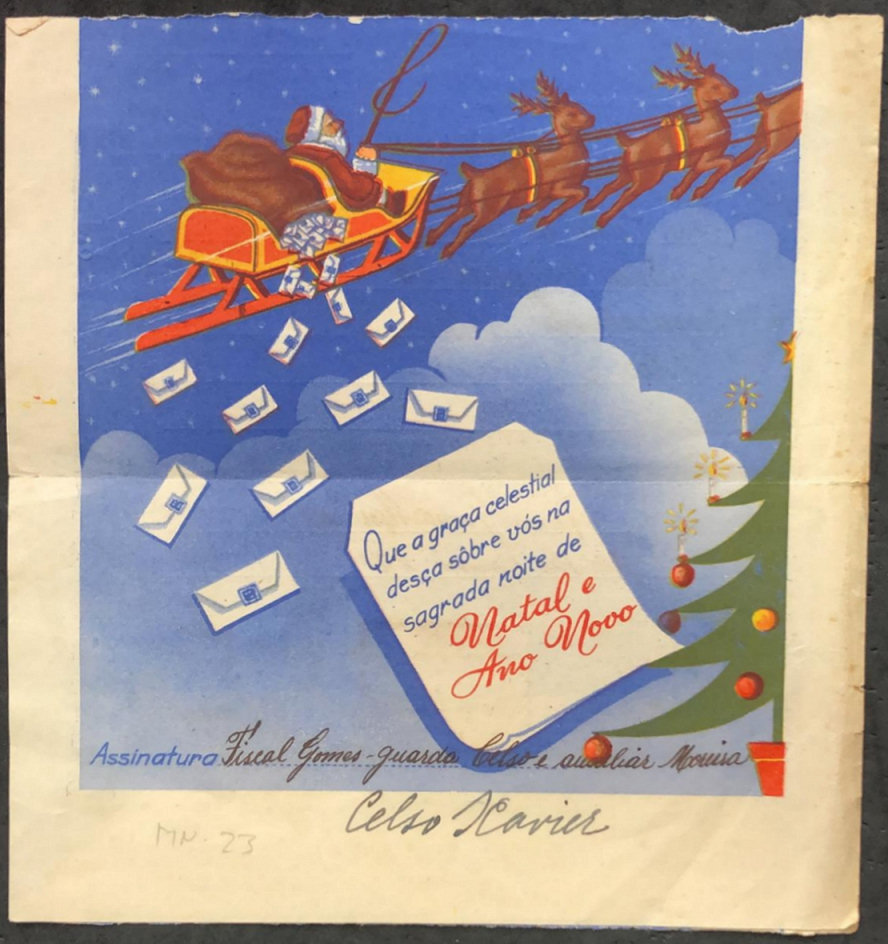
Image includes many of these envelopes with seals. |
Images courtesy of Beto Assef Filatelia (click an image for the listing).
Receipts.
This is a receipt for the Government Telegraph, dated 10 March 1889 and used in Petropolis.
A Reply Paid word count can also be recorded on it.
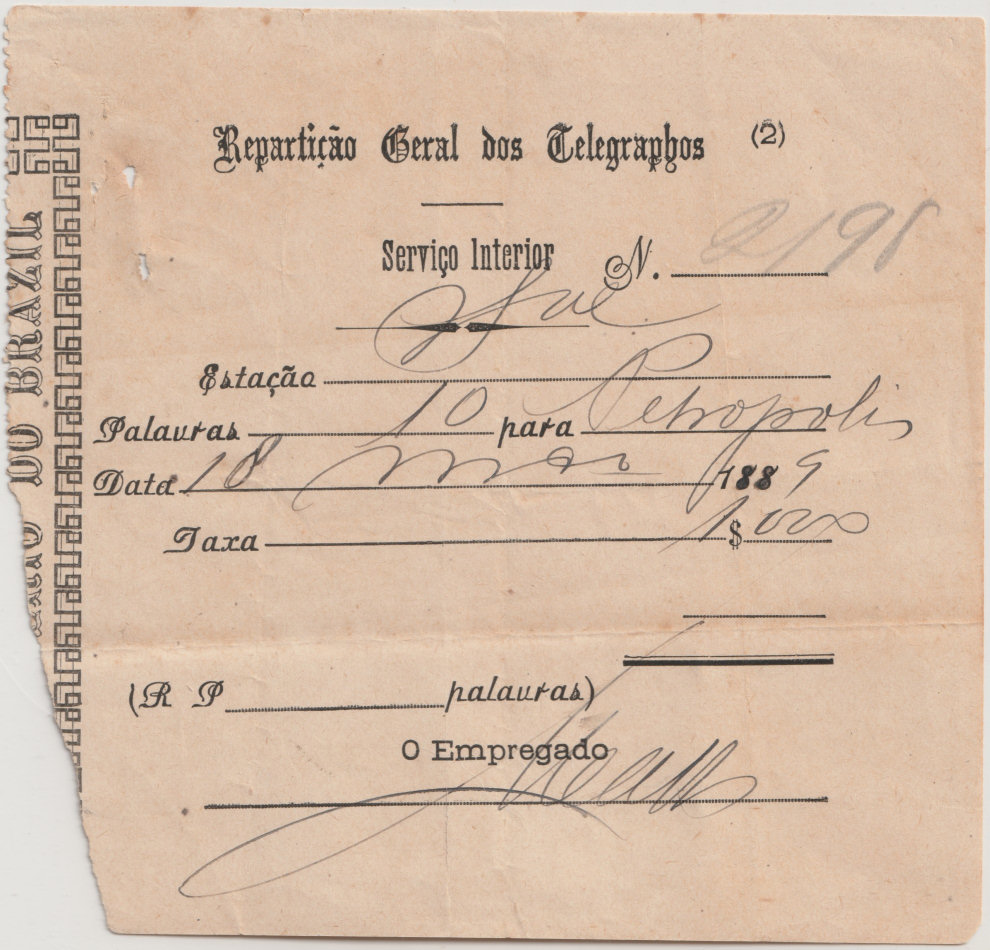
Image Courtesy of Gabriel Coutinho de Gusmão.
Modelo 3 v.p. Telegraphic Money Transfer dated 9 January 1918. Fiscal stamp indicating 50$000 sent from from Alagoas to Bahia. The 600R stamp presumably was the cost of the transfer.
An official staple of The receiving Post Office is shown.
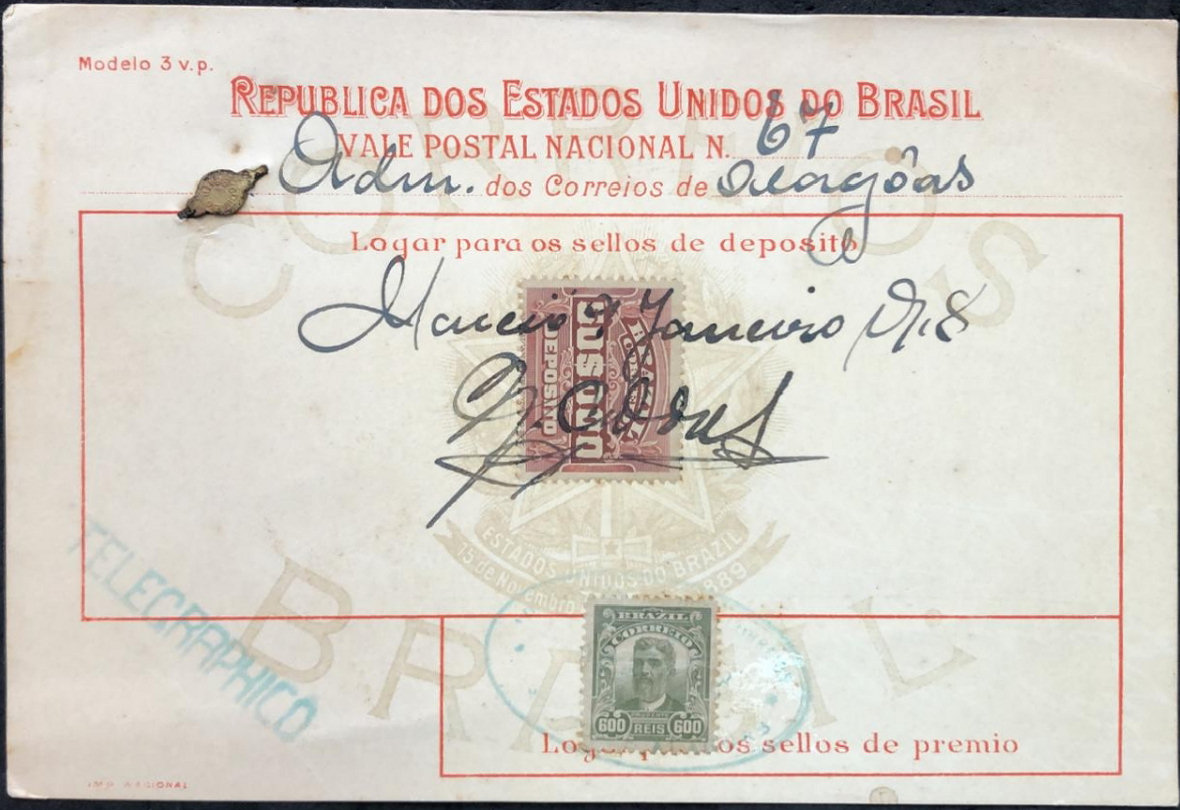
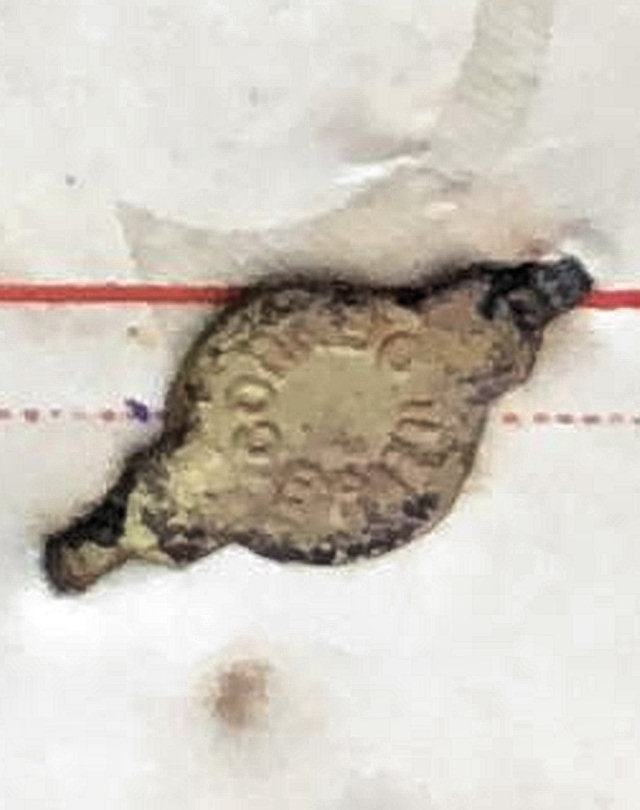

"IMP. NACIONAL" printer imprints at bottom-left each side. Images courtesy of Beto Assef Filatelia (click an image for the listing).
Western & Brazilian Telegraph Co.
A receipt for "The Western & Brazilian Telegraph Co. Ltd." dated 27 March 1886 and used in Rio de Janeiro.
(17) in top-left corner.

Image Courtesy of Gabriel Coutinho de Gusmão.
Western Telegraph Co. (Undersea cables)
This is the Western Telegraph, imprint-dated 1916 and used 27 November 1918 in Rio de Janeiro.

It shows a map of available routes.
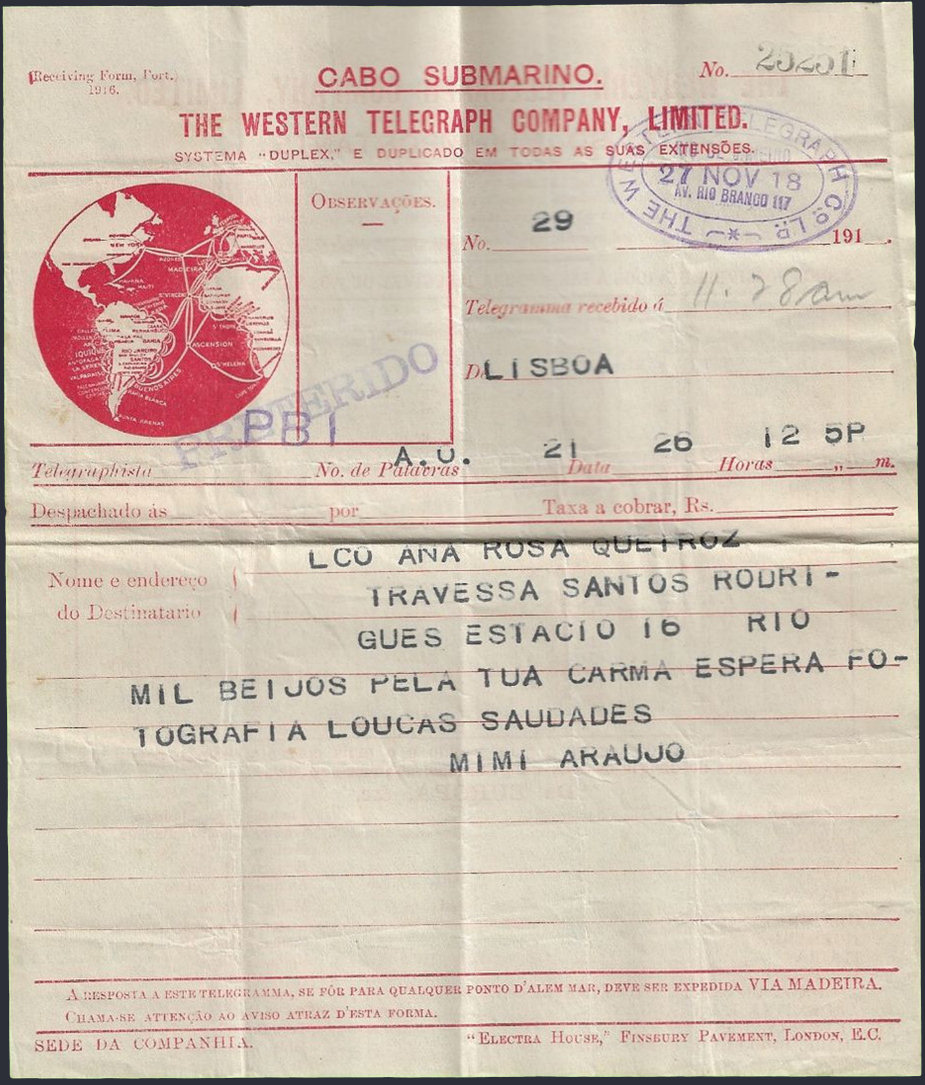
The bottom-right of the front gives the Head Office address as "Electra House at Finsbury Pavement, London, E.C."
The back contains "Very Important information".
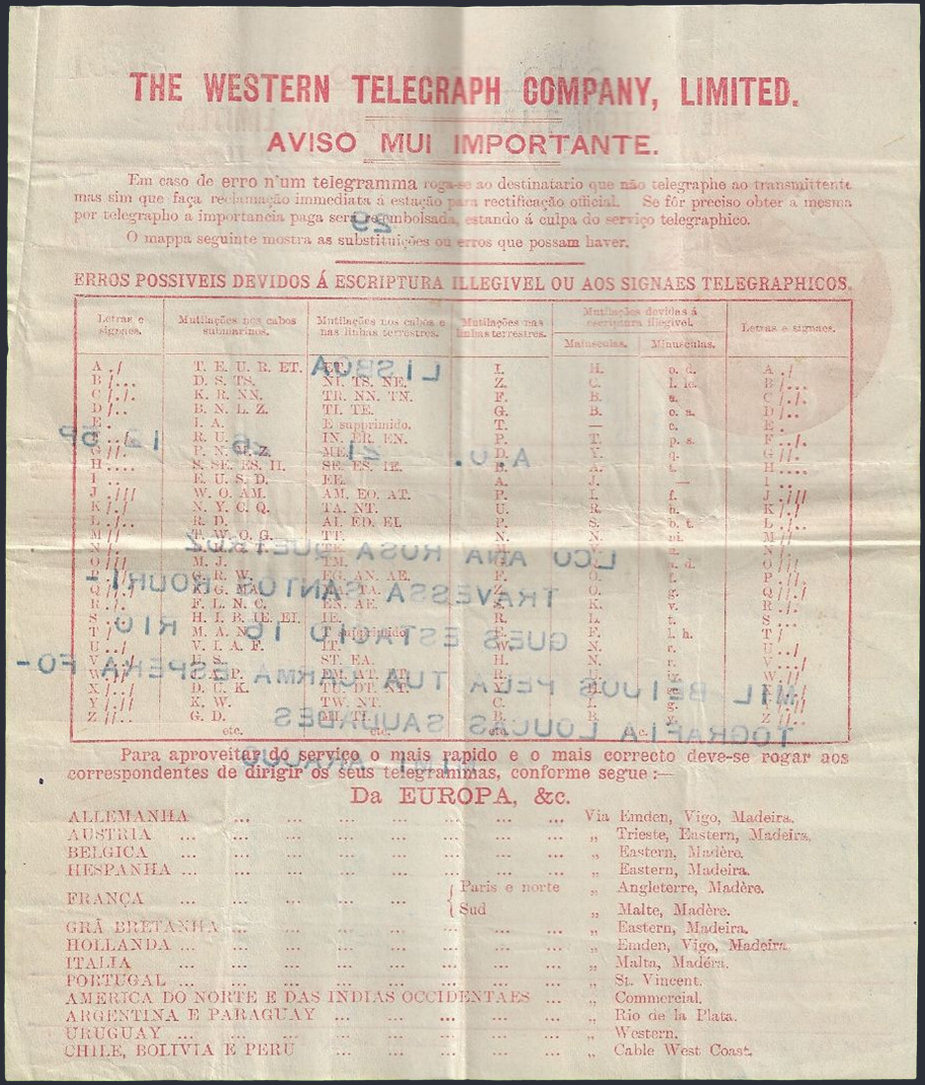
A later Western Telegraph, imprint-dated 1947 and used in 19 July 1950 in Porto Alegre.
Now affiliated with Cable & Wireless. A Logo in place of the map.

The back contains information.
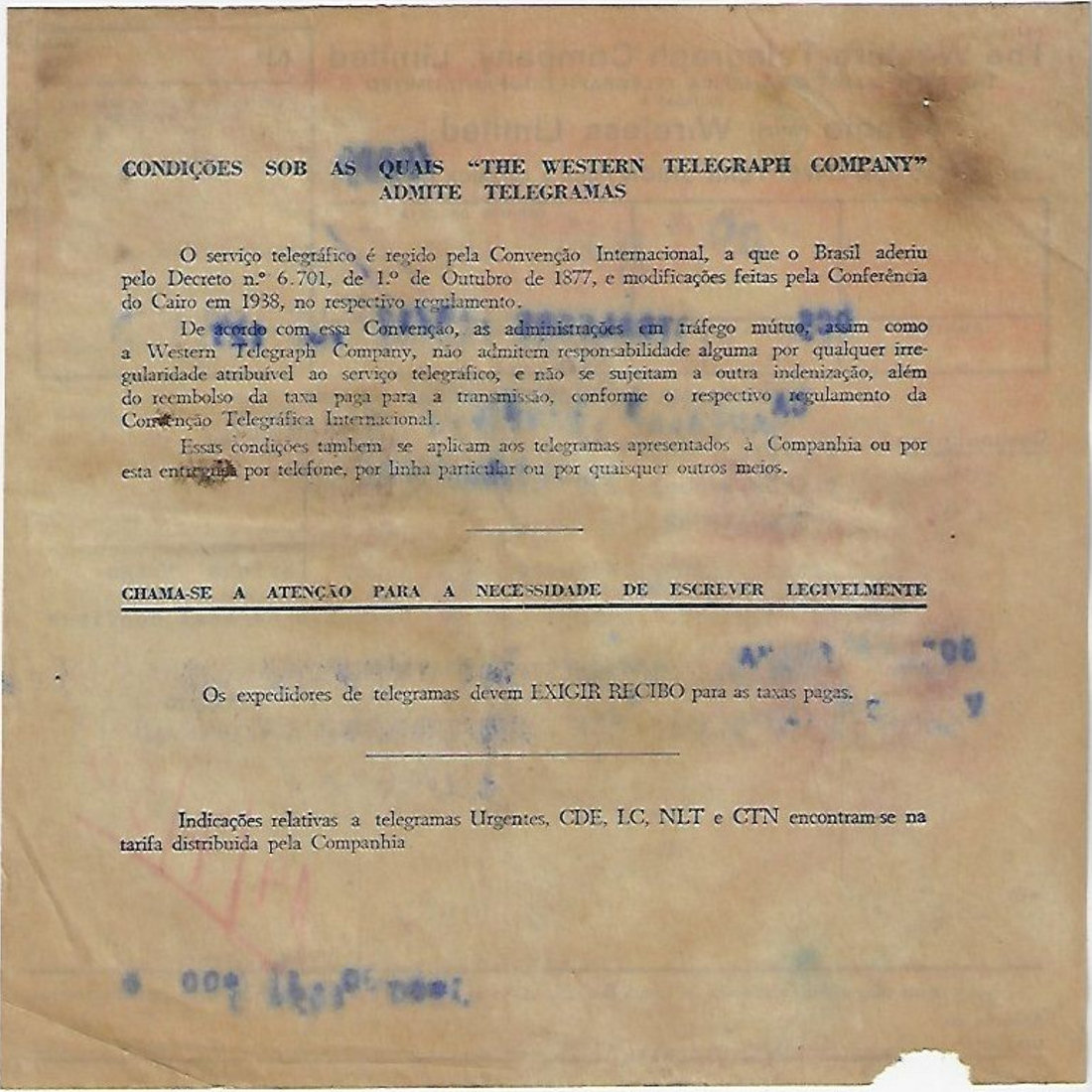
This is the Western Telegraph, imprint-dated 1968 and used in Sao Paulo.
Cable & Wireless is mentioned at the bottom, but Western Union is mentioned at the top. Nothing on the back.
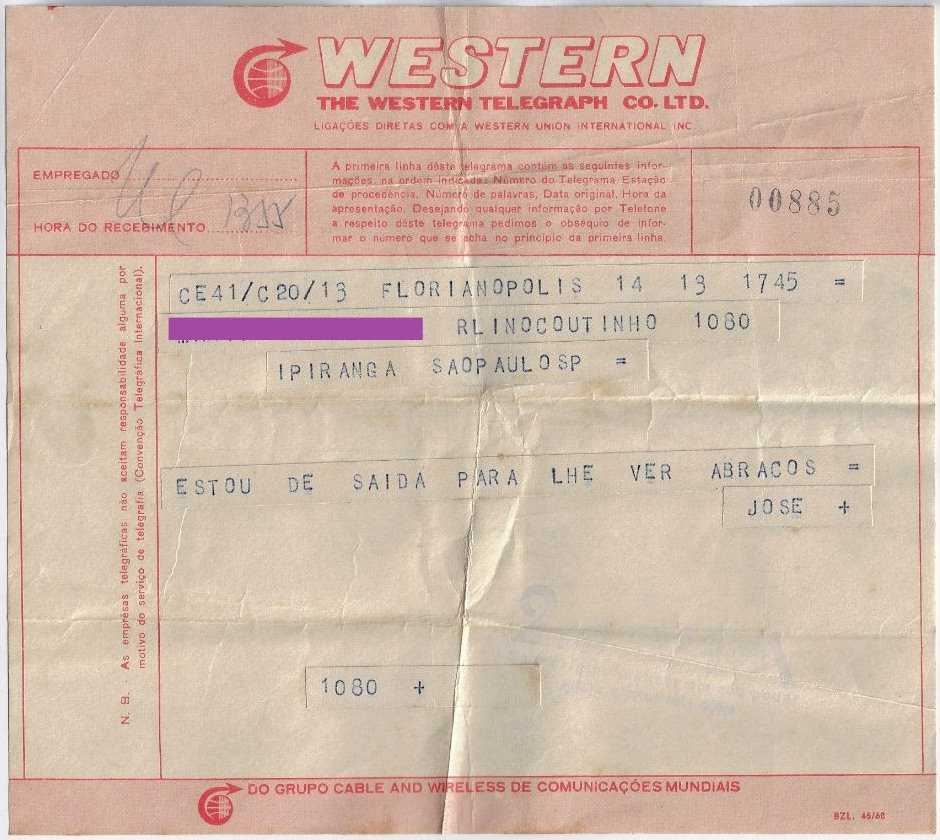
An imprint at bottom-right indicates it was printed in Brazil in the 45th week of 1968.
Front and back of the envelope used :


Receipts.
The Western Telegraph Co. Ltd., dated 18 May 1917 and used in Rio de Janeiro.
A form date of 1915 at top-left. "Preterido" = "Deprecated" has been stamped on it.

Image Courtesy of Gabriel Coutinho de Gusmão.
Rio Grandense.
COMPANHIA TELEPHONICA RIO GRANDENSE
Despite the name, this is a telegram of 28 January 1919. It lists numerous Offices and bears a company seal.
"Modelo u. 9" at top-left. Headquarters given as Marechal Floriano No. 77, Porto Alegre (capital of the state of Rio Grande do Sul).
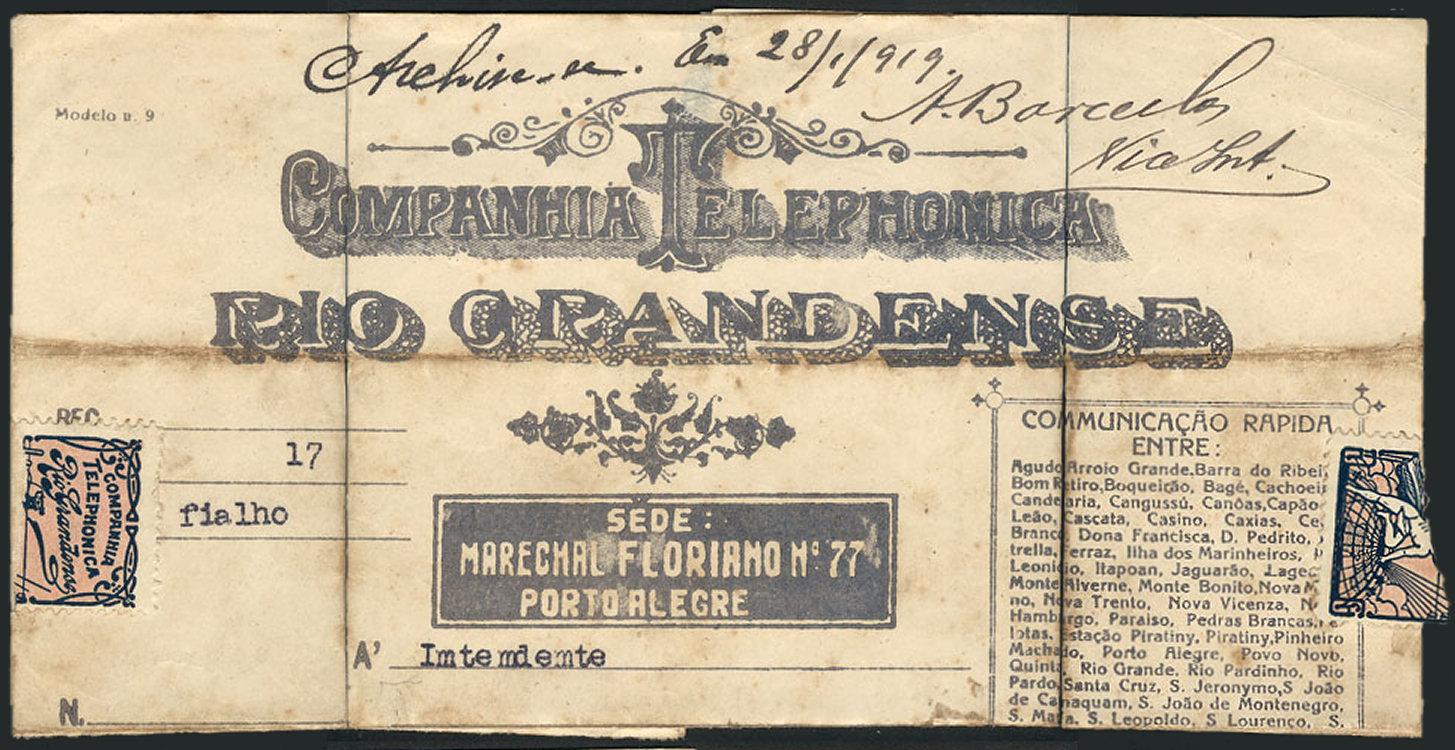
This much later "Social Message" is dated 14 December 1946.

The bottom carries disclaimers and a couple of imprints:
On the left is "Liv. Globo", probably the printer, and on the right is "TF. 1016B", presumably the Form number.
Image courtesy of Beto Assef Filatelia (click image for listing).
TT "del Plata"
COMPAÑÍA TELEGRÁFO-TELEFÓNICA NACIONAL (later taken over by Western).
"TT" Rosario telegram of 10 July 1928. It lists Offices in Santa Fé, Rosario, Buenor Aires and Montevideo.
It advertises international connections to Brazil, Europe, North America etc.
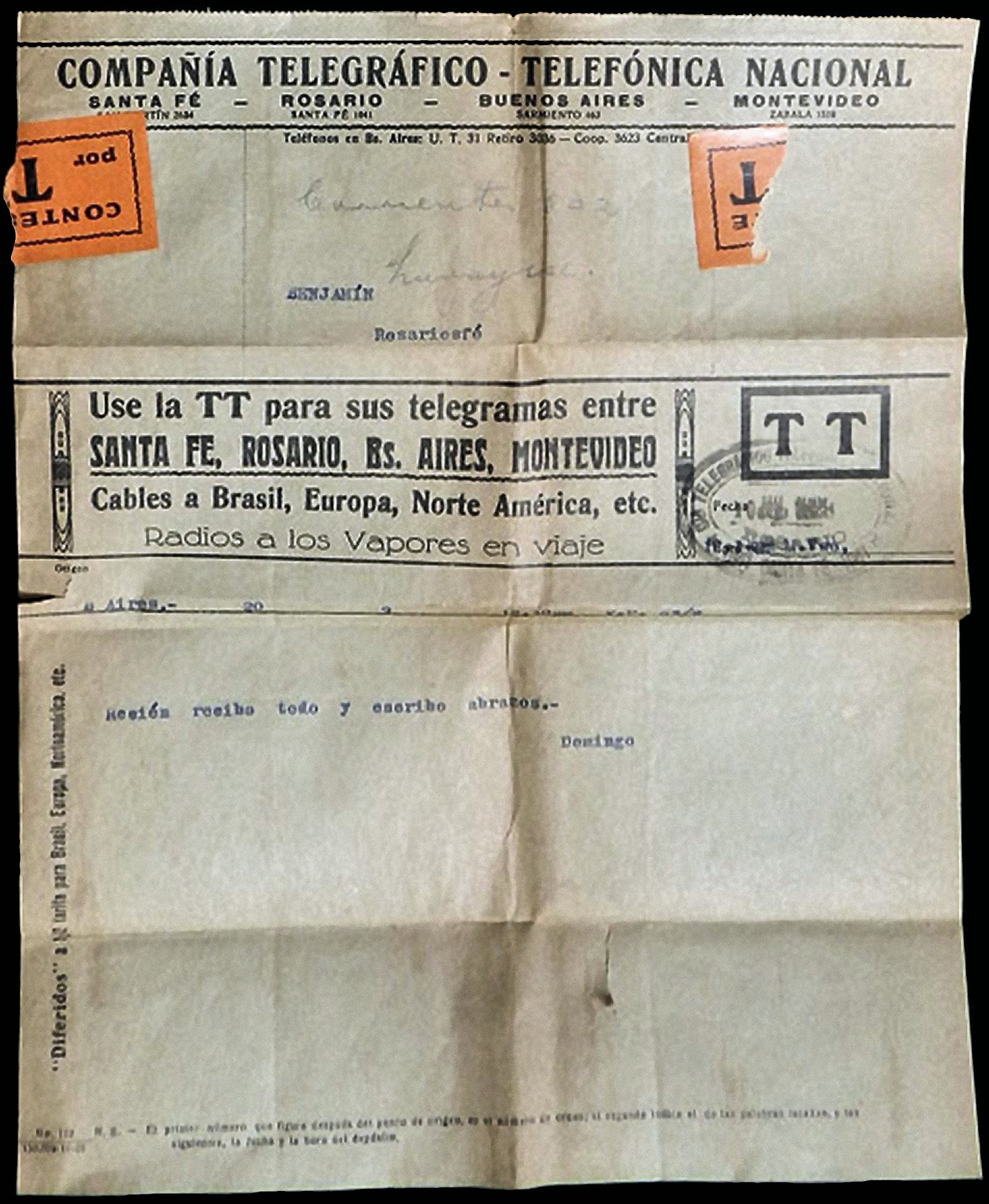
COMPAÑÍA TELEGRÁFO - TELEFÓNICA DEL PLATA
This is probably the local part of the rest of the company that was taken over by Western.
"TT" del Plata telegram of 8 April 1931. Form number at bottom-left reads "No. 1 V. B. / 25.000-12-30" which probably indicates 25,000 printed in December 1930.
It advertises international connections to Brazil, Europe, North America etc.
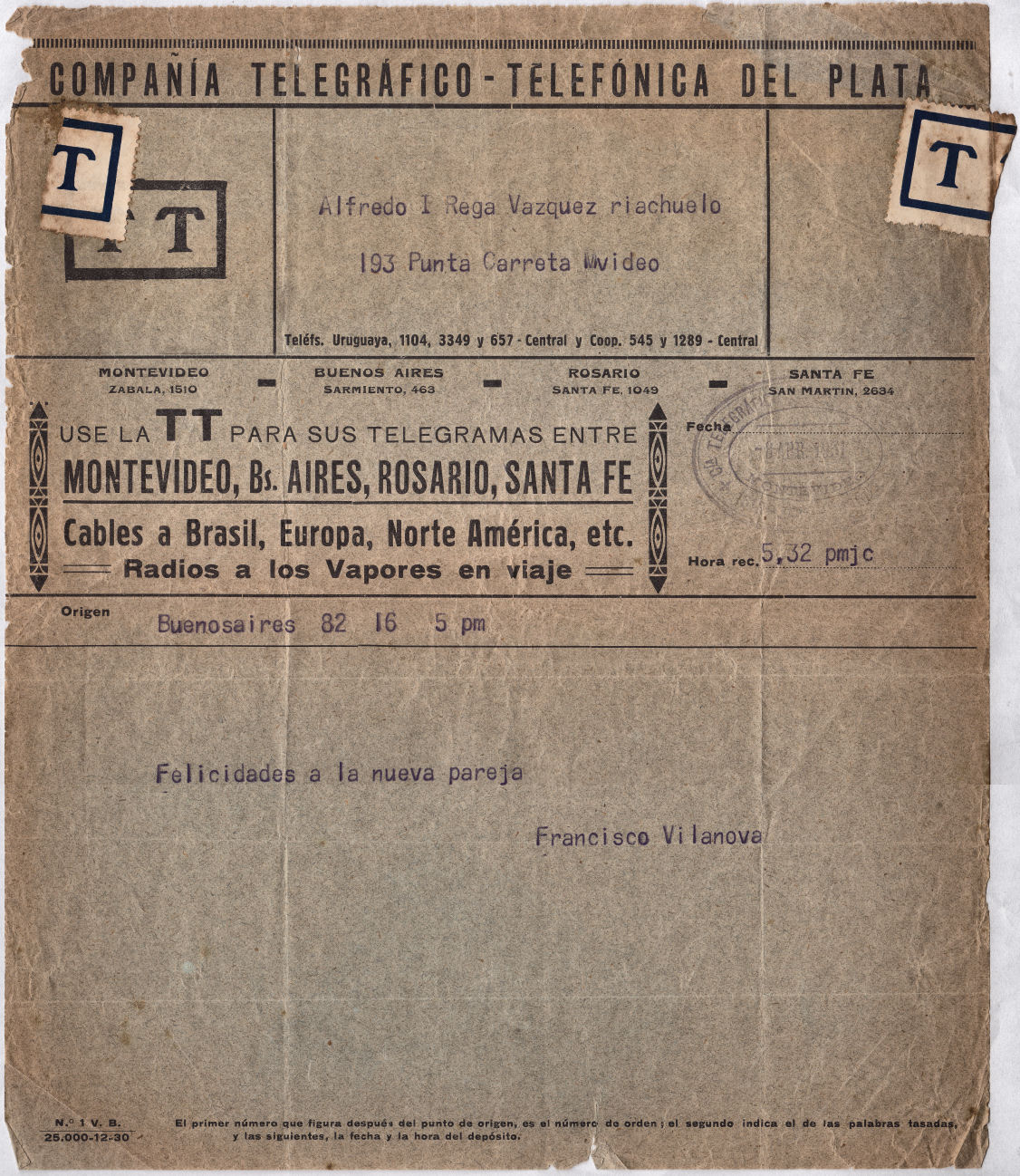
Used in Montevideo, but clearly operating in Buenos Aires, Rosario and Santa Fe of Argentina as well.
ItalCable.
This is front and back of an Italcable Telegram received at their office in Buenos Aires from Geneva on 5 July 1930.
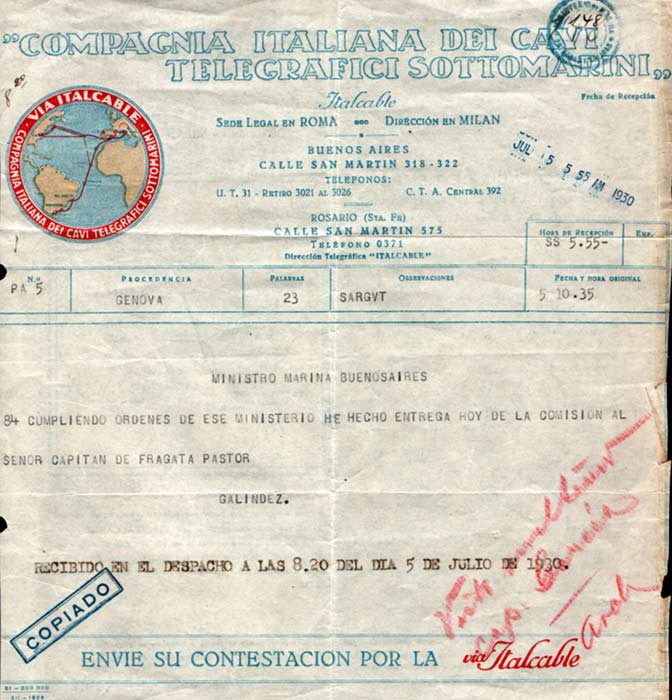
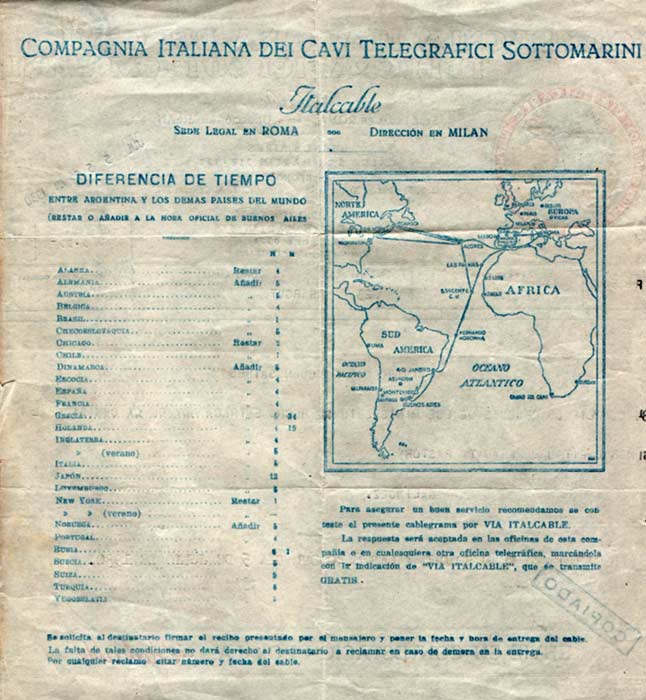
The back has information about offices and shows a map of available routes.
Carta Pneumatica
As with countries like France in Europe, Brazil had Pneumatic systems in Rio de Janeiro and São Paulo for rapid mail delivery.
Though not actually telegraphic, they were used as an aid to telegram delivery, so as with France, I will attempt to list them.

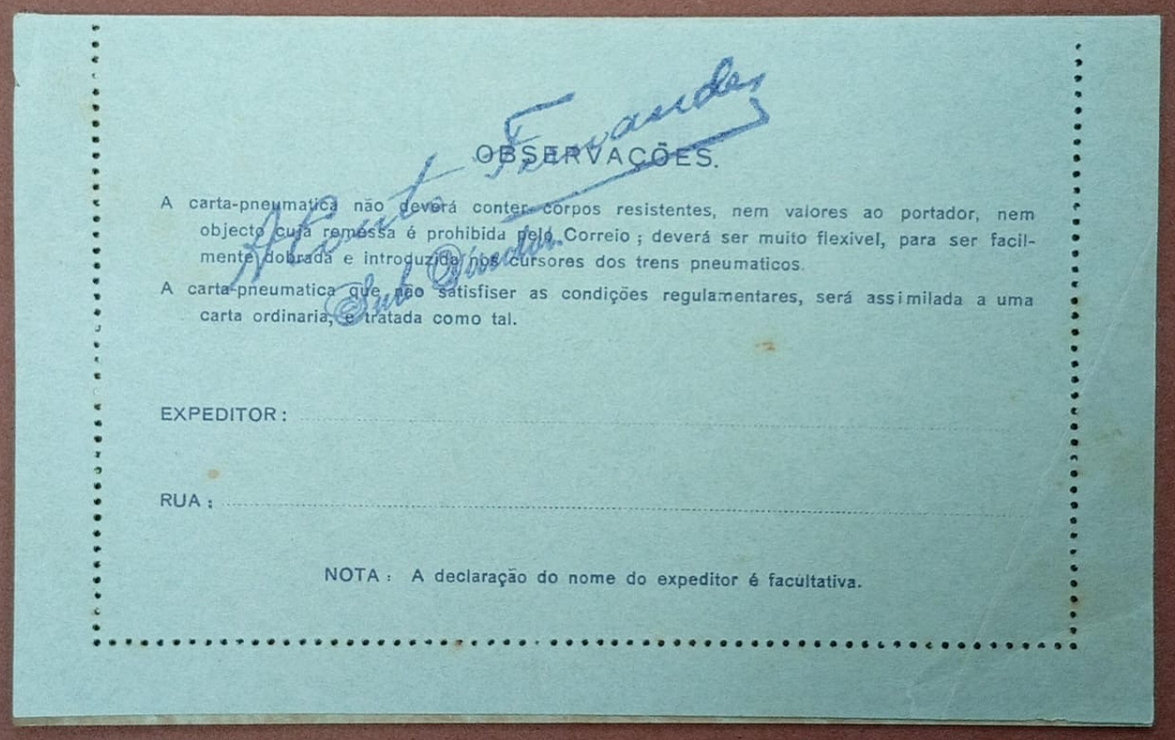
Described as CP-09, courtesy of Beto Assef Filatelia (click image for listing). (displayed small, download or display in another tab to see larger)
A used example of 1913 has been seen.
The front has a 300 Reis stamp impression, on which I have seen two types of 500R, a 600R and 1000R overprints used.
The back has two Observations and a Note:
"A carta-pneumatica não deverá conter corpos resistentes, nem valores ao portador, nem objecto cuja remessa é prohibida pelo Correio ;
deverá ser muito flexível, para ser facilmente dobrada e introduzida nos cursores dos trens pneumaticos.
A carta-pneumatica que não satisfiser as condições regulamentares, sera assimilada a uma carta ordinaria, e tratada como tal.
NOTA: A declaração do nome do expeditor é facultativa."
or :
"The letter-pneumatic must not contain resistant bodies, nor values to the bearer, nor object whose shipment is prohibited by mail ;
it must be very flexible, to be easily folded and inserted into the sliders of pneumatic trains.
The letter-pneumatic that does not satisfy the regulatory conditions, will be assimilated to an ordinary letter, and treated as such.
Note: the declaration of the name of the consignor is optional."
The back often has a handstamp of the Sub-Director which can be of at least two types, one in purple but the rarer in blue.
They can be at various angles. I do not yet know the significance of this.
|
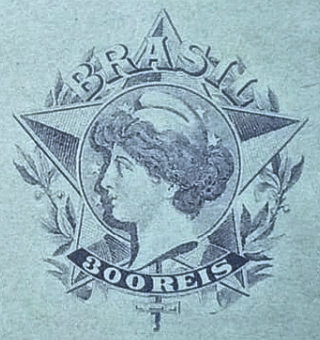 |


Two types of Sub-Directors signature, one usually in blue (I will call Type I), the other, wider and usually in purple (I will call Type II). I think the blue is the earliest.
Overprints :
The overprints I have seen at the same scale (I don't actually know what that is).

I have seen this described as Type I, 72 x 5.

The hyphen "-" in the small 500R overprint is well spaced from the surrounding characters.
I have seen this described as Type II, 84 x 7.
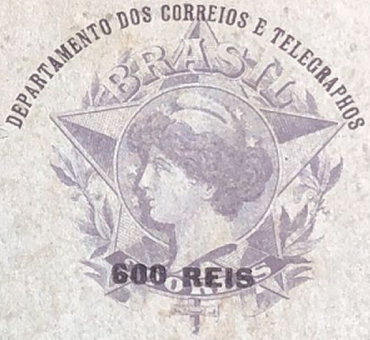
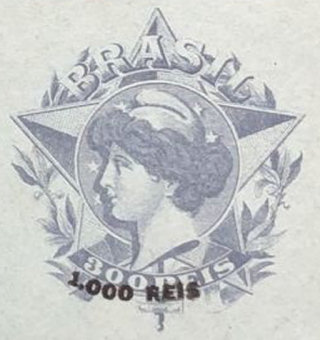
Small 500R (in black) on 300R. Blue Sub-Directors signature. Used 16 November 1917.


Described as RHM CP 10 - em 1917 - 2500 ufs - E 18. Images courtesy of Beto Assef Filatelia (click image for listing). (displayed smaller, download or display in another tab to see larger)
Small 500R (in blue) on 300R. Blue Sub-Directors signature. Unused
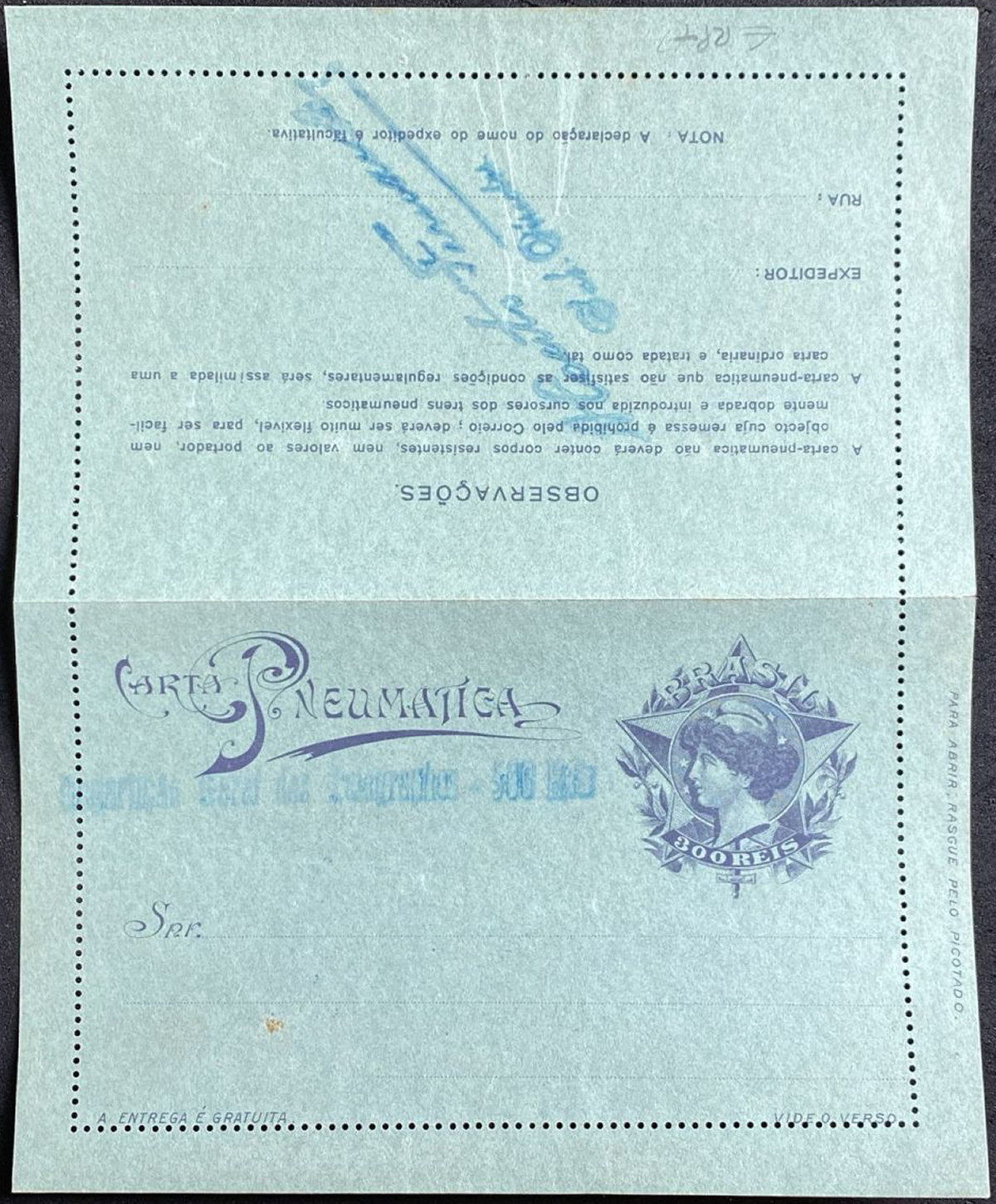

Described as (CP-10) Azul Turquesa - Nova - 800 Ufs . Images courtesy of Beto Assef Filatelia (click image for listing). (displayed smaller, download or display in another tab to see larger)
Small 500R (in blue) on 300R. Blue Sub-Directors signature. Used.
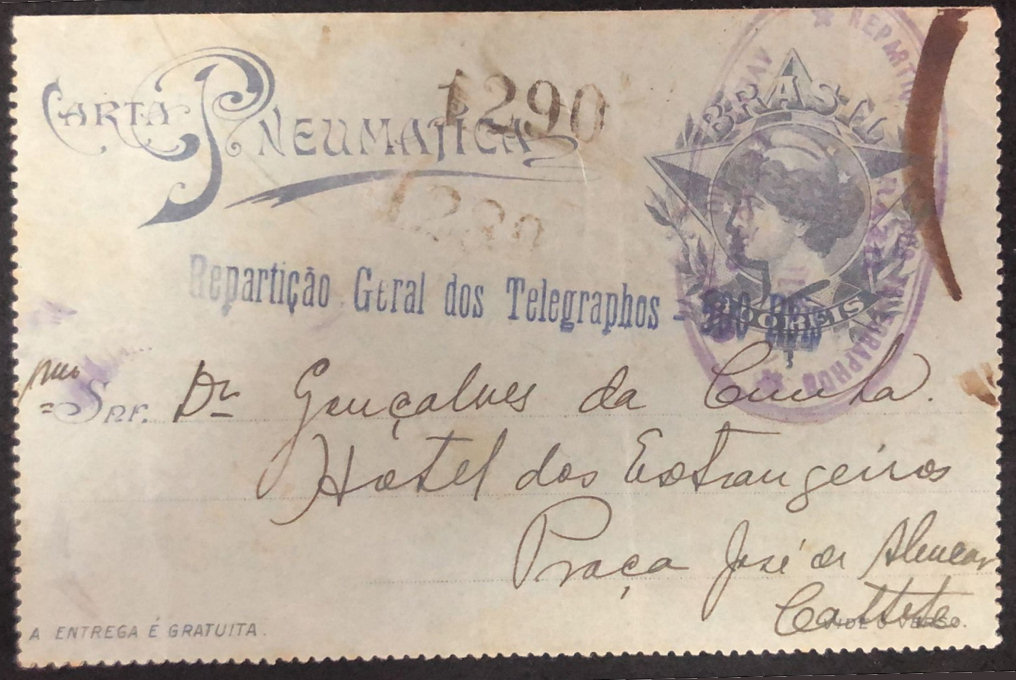
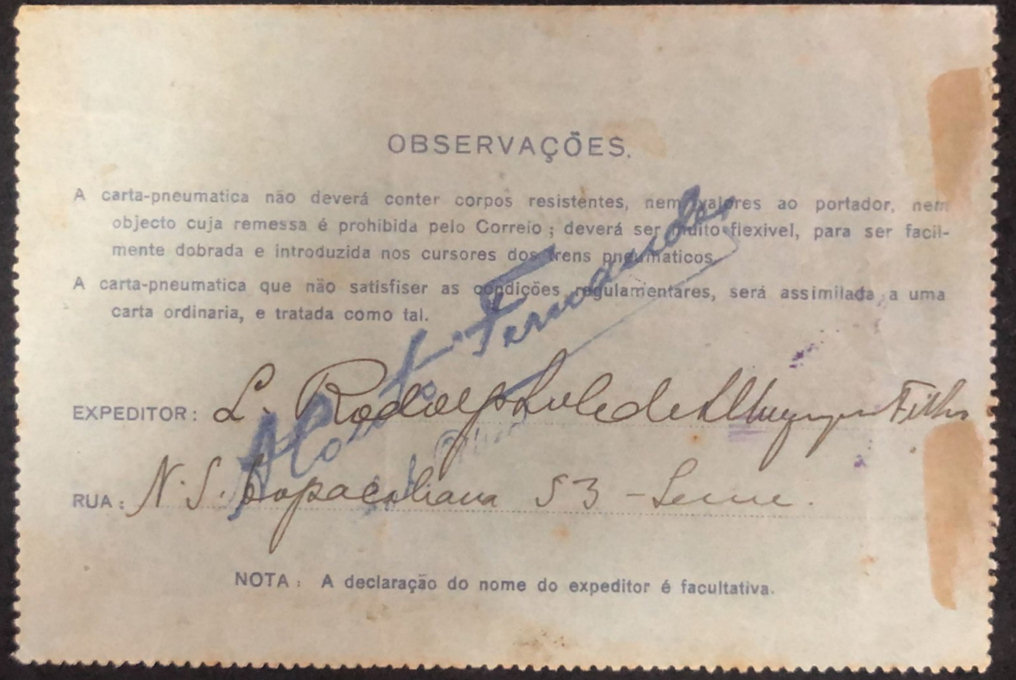
Described as surcharged in Blue. Could be CP-10, courtesy of Beto Assef Filatelia (click image for listing). (displayed small, download or display in another tab to see larger)
Large 500R on 300R. Purple Sub-Directors signature. Used 13 May 1915.

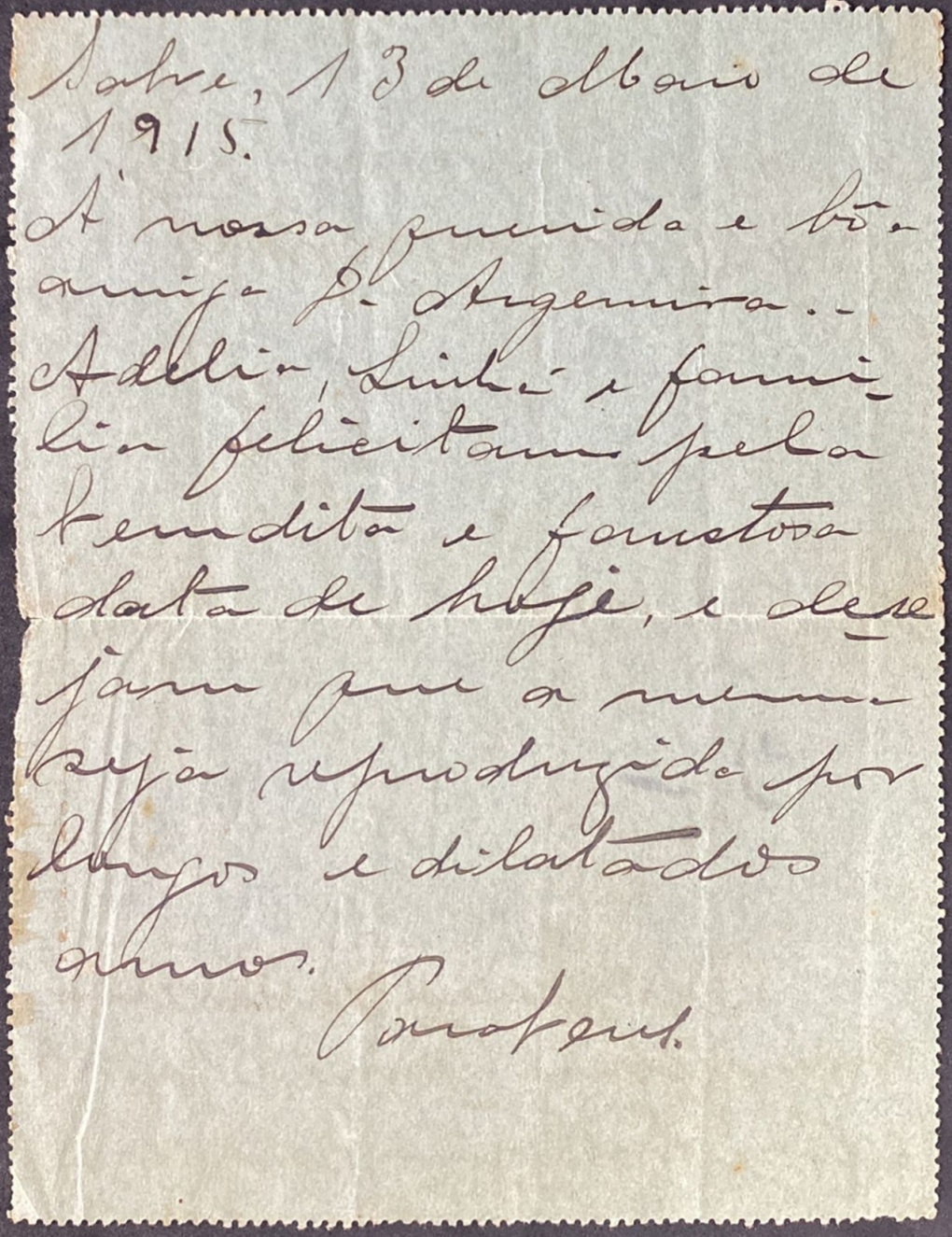
Described as Tipo I, sobrecarga azul - RHM CP-11 - Usada - 2500 Ufs , courtesy of Beto Assef Filatelia (click image for listing). (displayed small, download or display in another tab to see larger)
Large 500R on 300R. Purple Sub-Directors signature. Used, the 11-17 on front bottom-right may indicate the date.
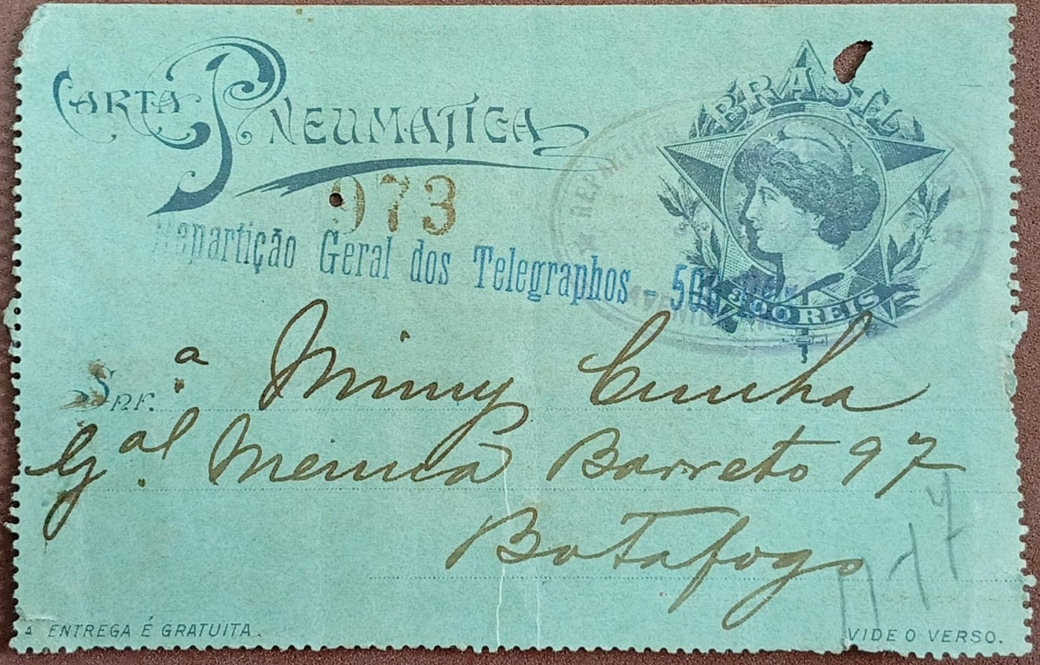
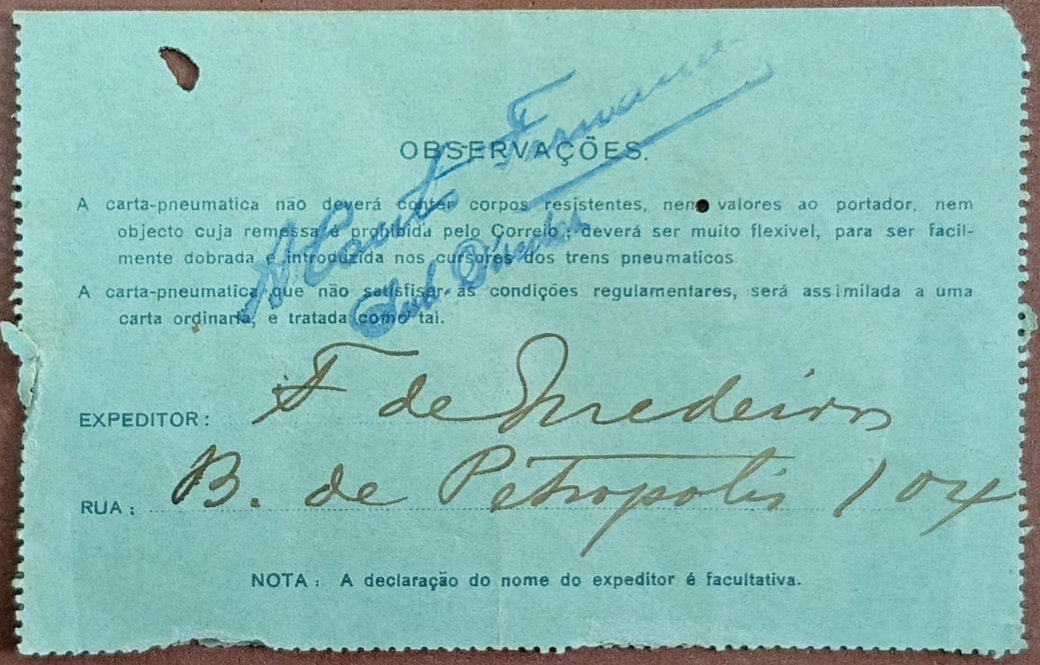
Described as Tipo 1 sobrecarga azul (72x5) - (CP-11) Pequeno furo - 2500 Ufs. Image courtesy of Beto Assef Filatelia (click image for listing). (displayed small, download or display in another tab to see larger)
Large 500R on 300R. Purple Sub-Directors signature.
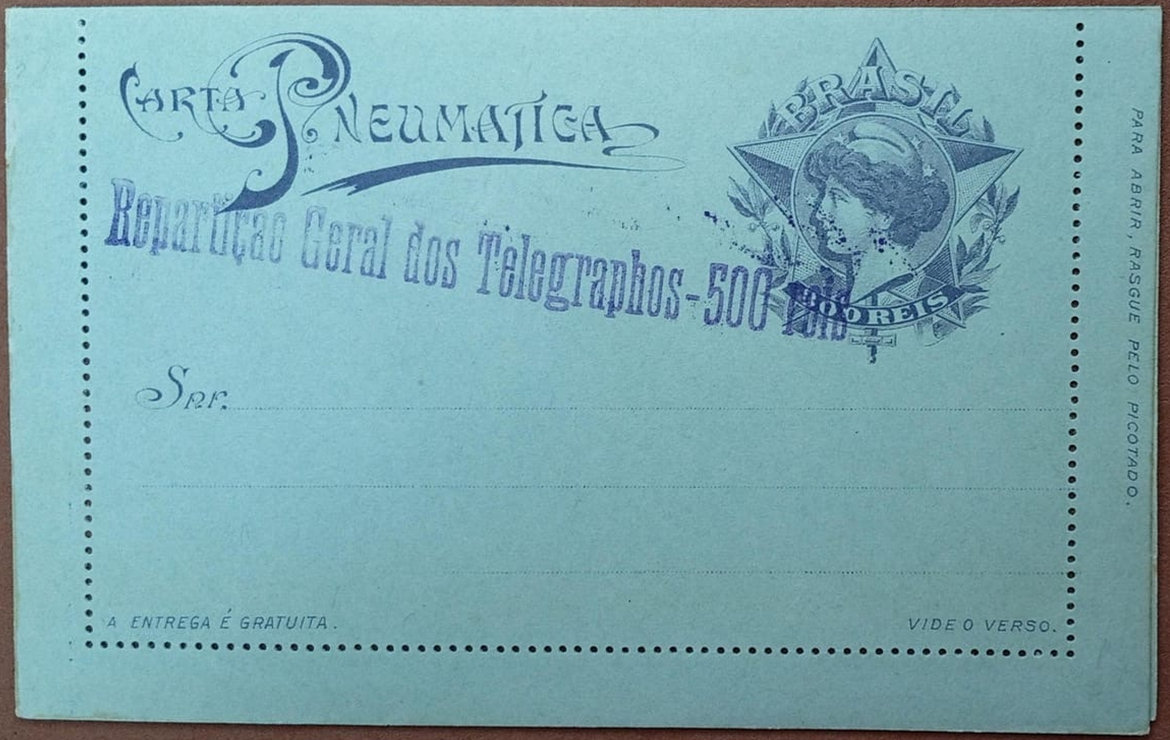
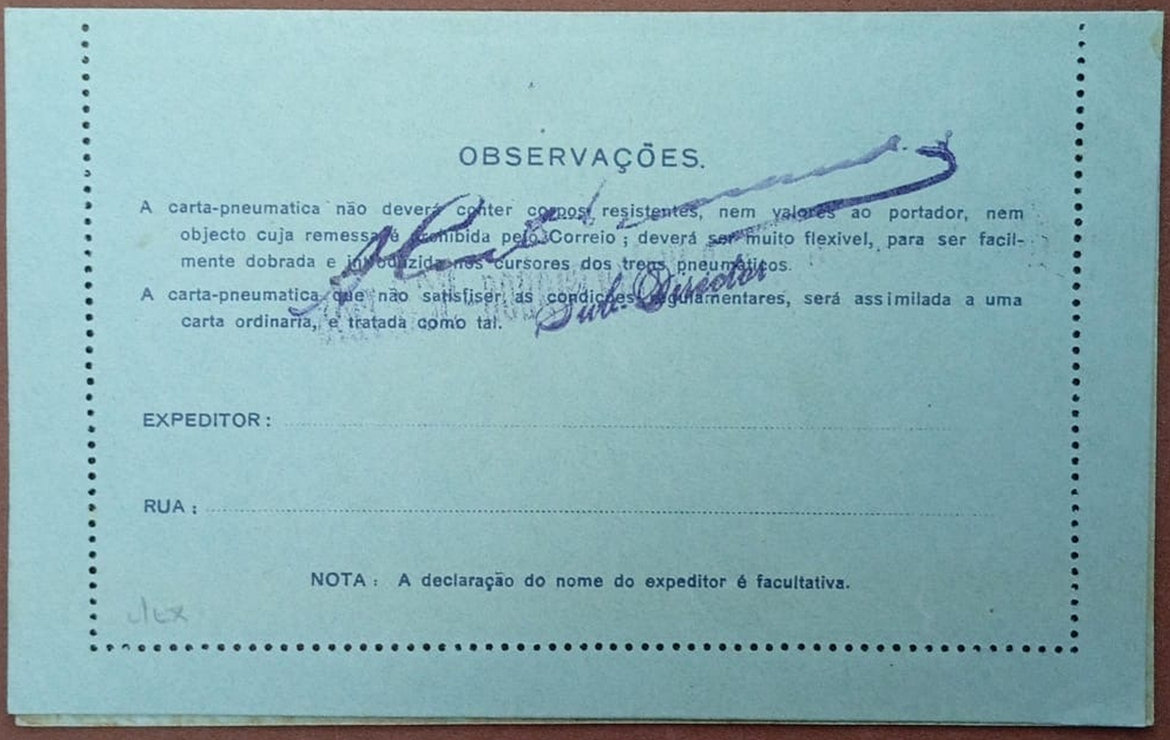
Described as CP-11 Sobrecarga azul, 800 ufs, courtesy of Beto Assef Filatelia (click image for listing). (displayed small, download or display in another tab to see larger)
Large 500R on 300R. Purple Sub-Directors signature. Used 20 May 1925.
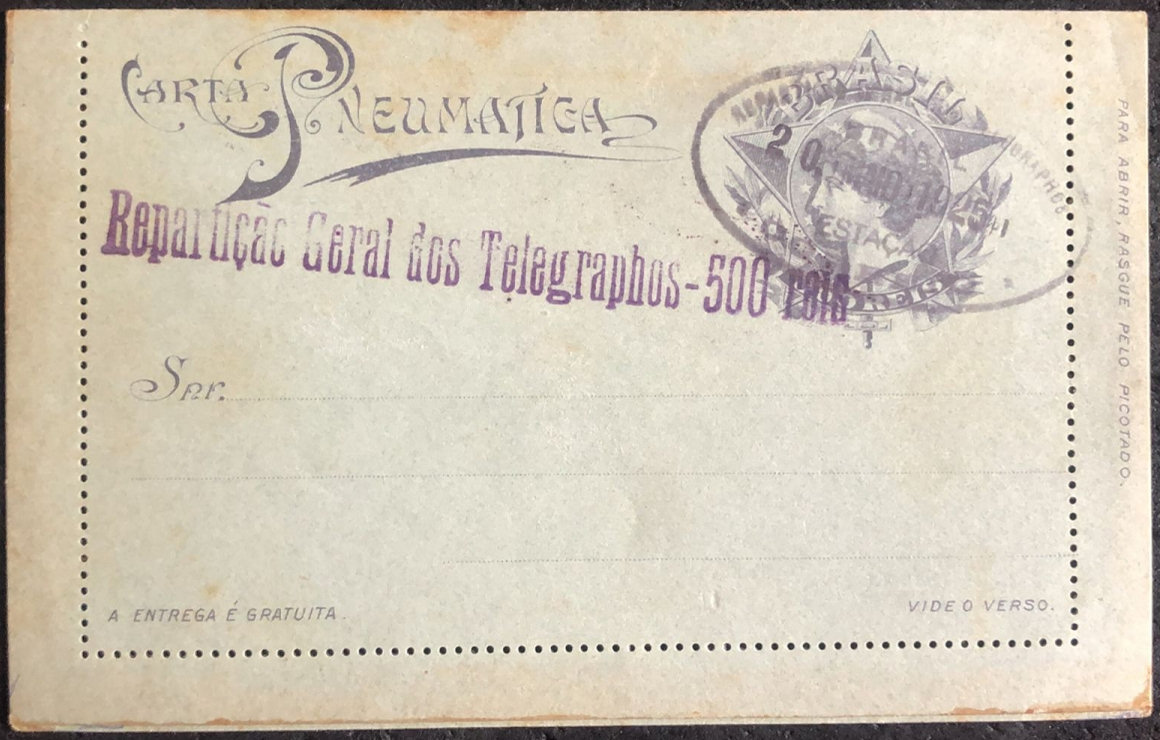

Described as 1919, CP-12, courtesy of Beto Assef Filatelia (click image for listing). (displayed small, download or display in another tab to see larger)
A very similar one, though whiter and unused, is described as "tipo II (84 x 7) - CP 13. 600 ufs ".
If that is the size of the 500R overprint in mm, then these are a lot smaller than I thought. I suspect a mistake.
Large 500R on 300R. Purple Sub-Directors signature. Used.
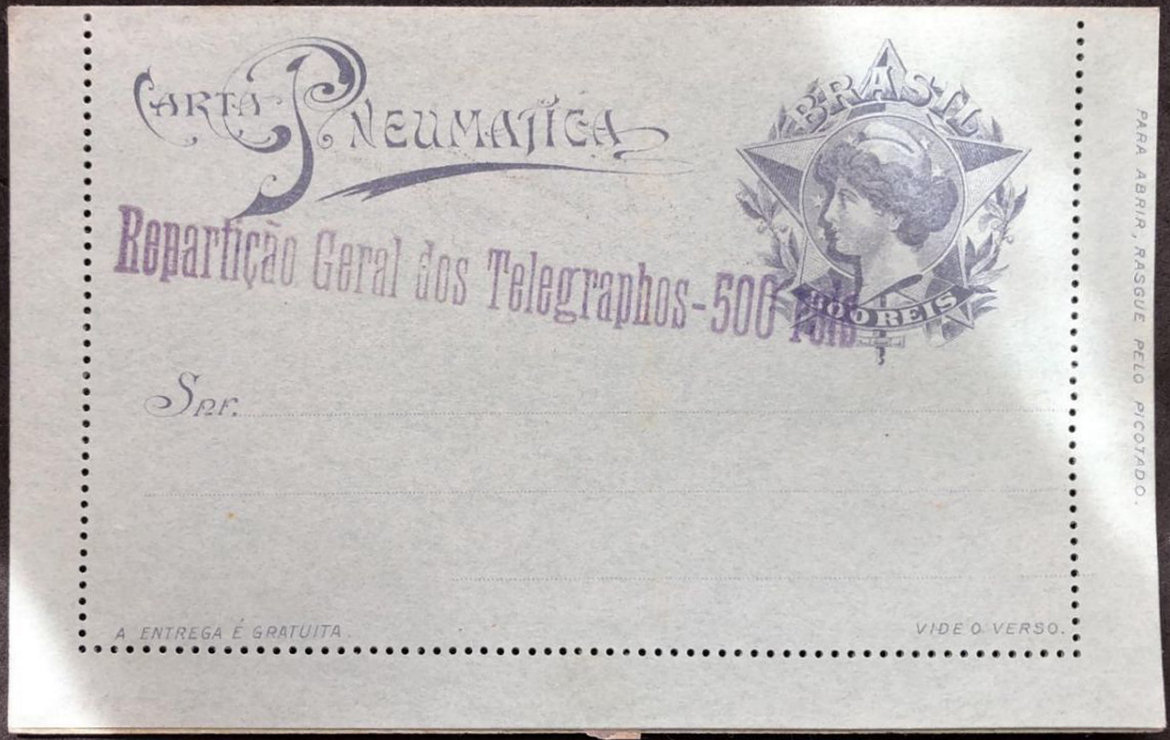
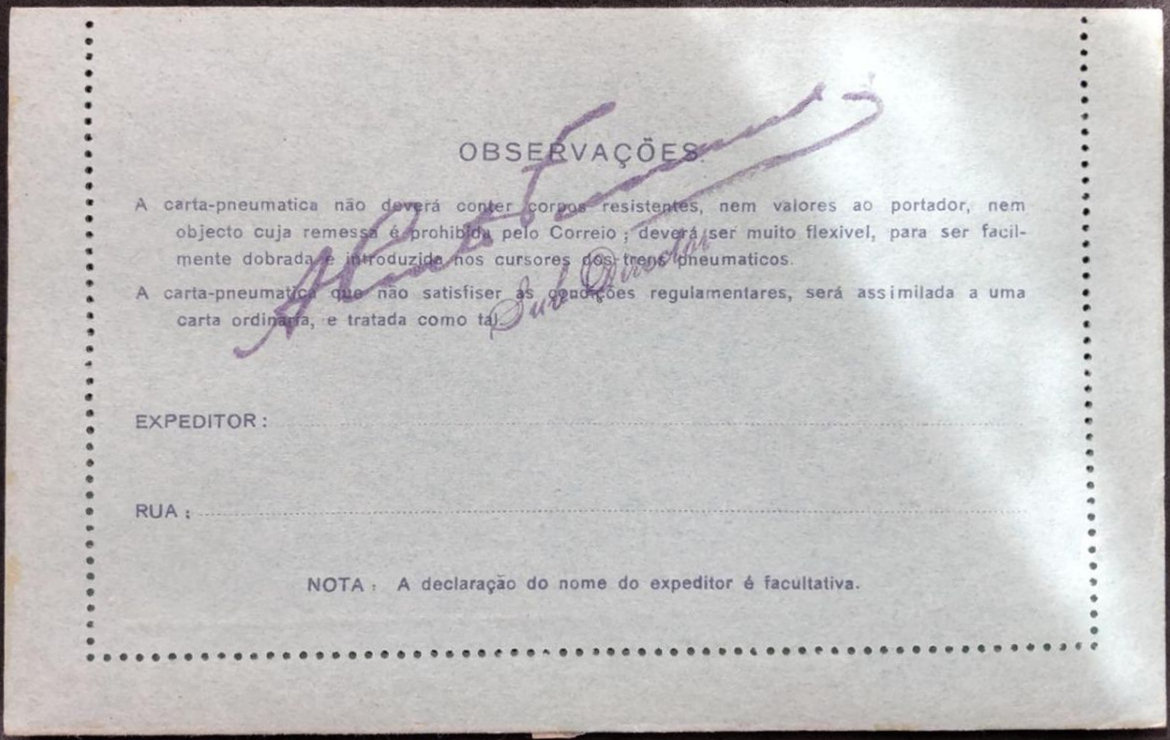
Described as CP-13 600ufs, courtesy of Beto Assef Filatelia (click image for listing). (displayed small, download or display in another tab to see larger)
Large 600R on 300R. No Sub-Directors signature.

Described as RHM CP-19, 1,600 Ufs, courtesy of Beto Assef Filatelia (click image for listing).
Large 1,000R on 300R. No Sub-Directors signature.
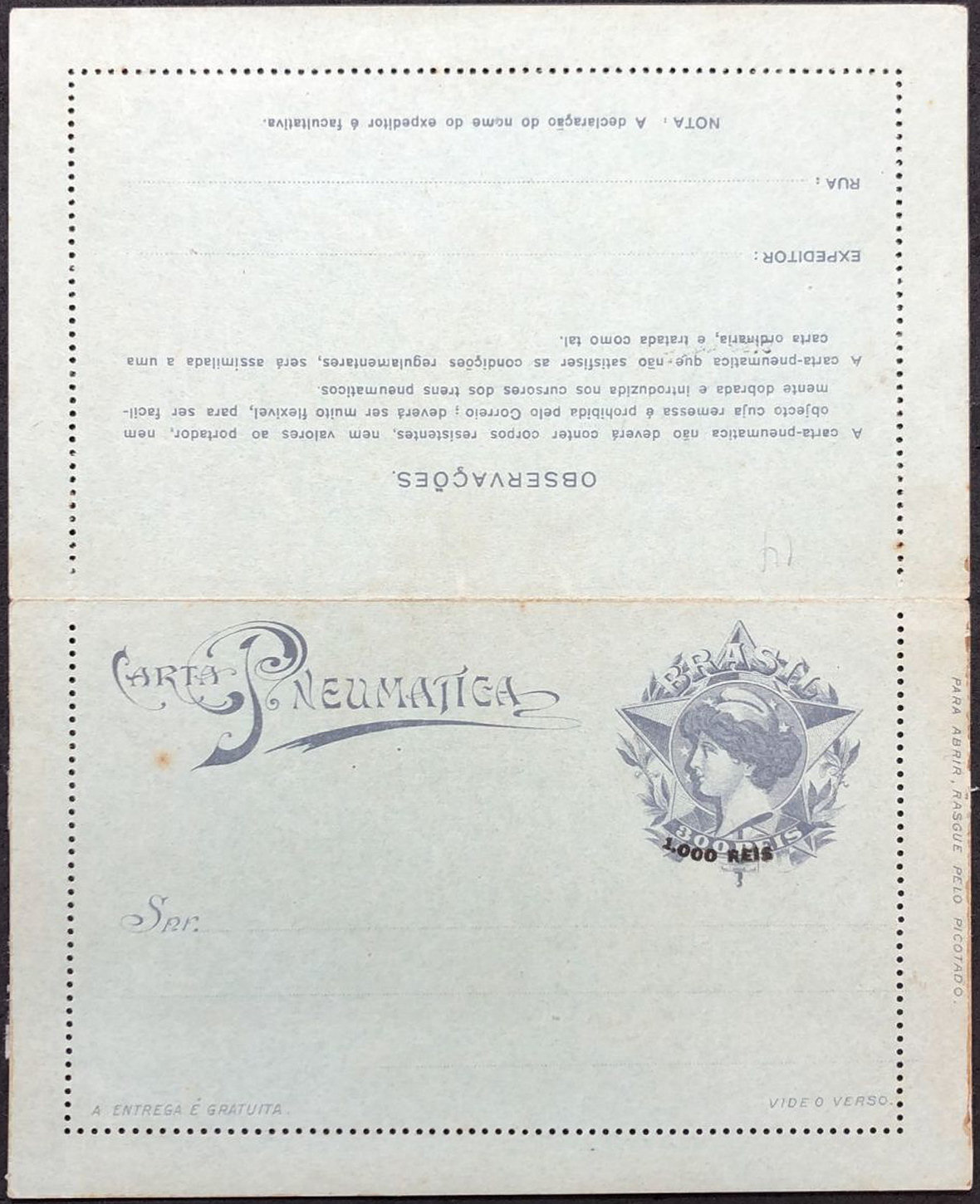
Described as RHM CP-20 3500 ufs - E 18. , courtesy of Beto Assef Filatelia (click image for listing).
Table of types/examples
| CP Type |
Value |
Colour |
Surcharge |
Use date |
Sub-Directors signature. |
| CP-09 |
300R |
blue-green |
None |
- |
Blue, Type I |
| CP-10 |
500R |
white to pale blue |
Black, Type I |
16 Nov 1917 |
Blue, Type I |
| CP-10 |
500R |
pale blue outside, white inside |
Blue, Type I |
- |
Blue, Type I |
| CP-10? |
500R |
white |
Blue, Type I |
? |
Blue, Type I |
| CP-11 |
500R |
white |
Blue, Type I |
13 May 1915 |
Blue, Type I |
| CP-11 |
500R |
blue |
Blue, Type I |
November 1917 ? |
Blue, Type I |
| CP-11* |
500R |
blue |
Violet, Type II |
- |
Violet, Type II |
| CP-12 |
500R |
white |
Purple, Type II |
20 May 1925 |
Purple, Type II |
| CP-13 |
500R |
white |
Purple, Type II |
- |
Purple, Type II |
| CP-19 |
600R |
white |
600R |
- |
None |
| CP-20 |
1000R |
white |
1000R |
- |
None |
CP-10 seems to have some surcharge colour variation. I do not know the difference between CP-12 and CP-13.
*Three are described as CP-11. The first two describe the surcharge correctly as Type I, the last does not. But what is the last?
I have gaps before CP-09 and from CP-14 to CP-18. More information would be very welcome.
Seals.
Four types are currently known.

From a Rio Grandense telegram
of January 1919. |
|

From about 1922 to 1926 on National Telegrams. |
|

Said to be from 1920/21, but should be later than the last.
Perhaps 1928 ? |
|

1980's ? Government produced, marked DCT for
Departmento dos Correios e Telégrafos
Boas Festos = Happy Holidays
There may be other seasonal ones. |
If anyone can provide scans to help with this page, I am happy to give appropriate credit.
Comments, criticisms, information or suggestions are always welcome.

Please include the word 'Telegraphs' in the subject.
Last updated 14th. July 2025
©Copyright Steve Panting 2012/13/14/15/16/17/18/19/20/21/22/23/24/25 except where stated.
Permission is hereby granted to copy material for which the copyright is owned by myself, on condition that any data is not altered and this website is given credit.


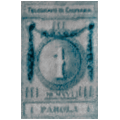
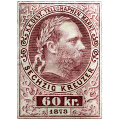
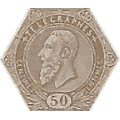
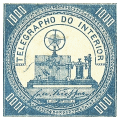
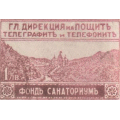
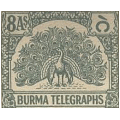
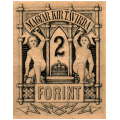
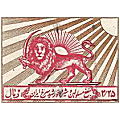
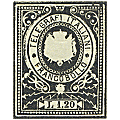
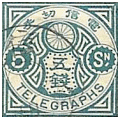
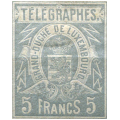
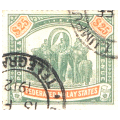
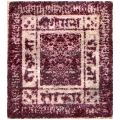
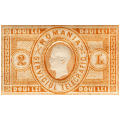
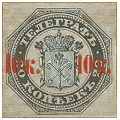
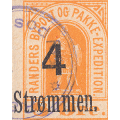
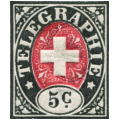

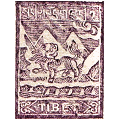
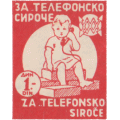
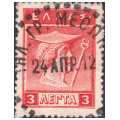
 A detailed map of Para can be found on
A detailed map of Para can be found on 



















































